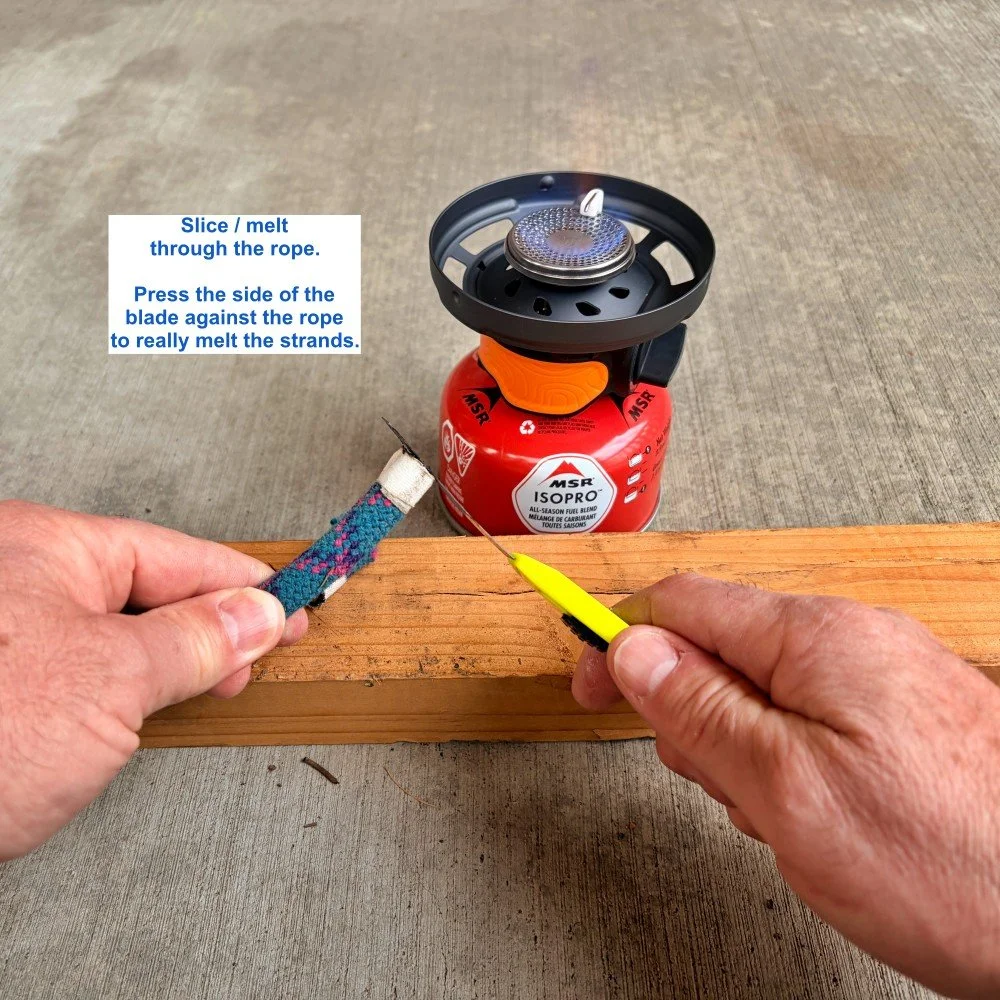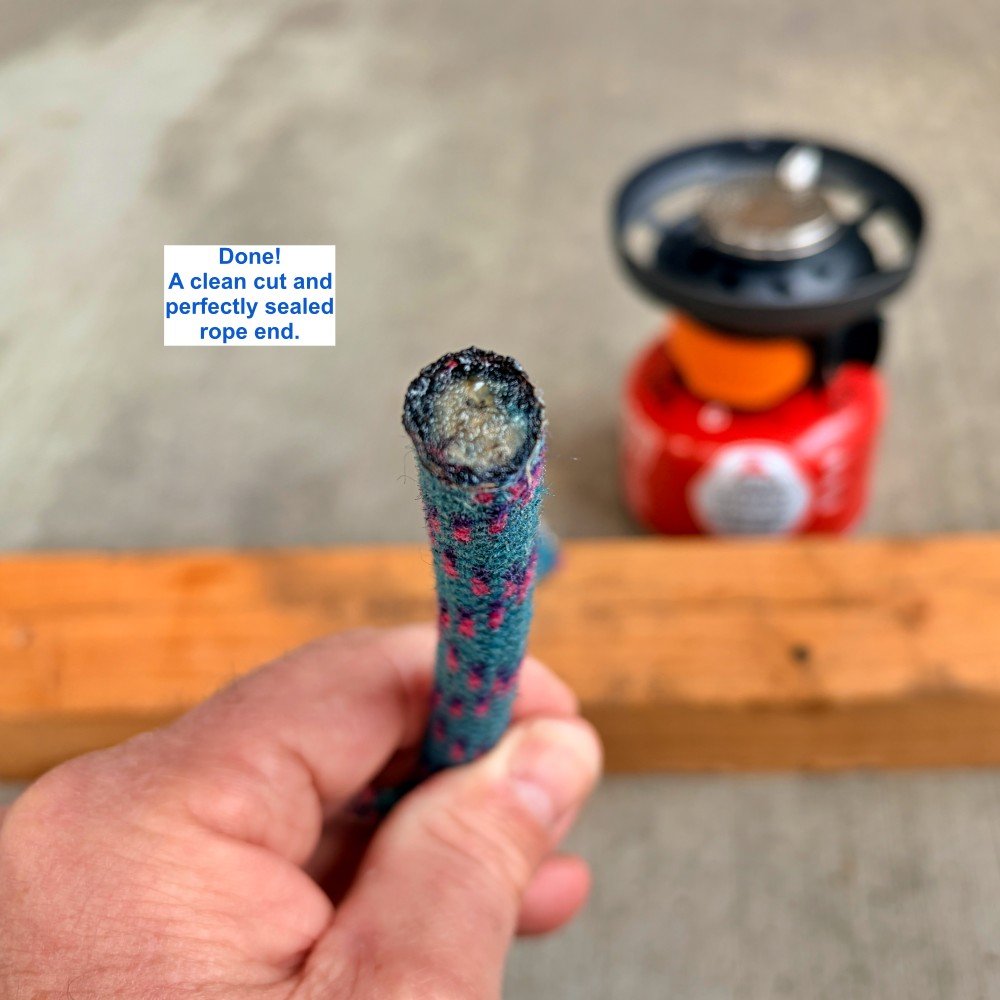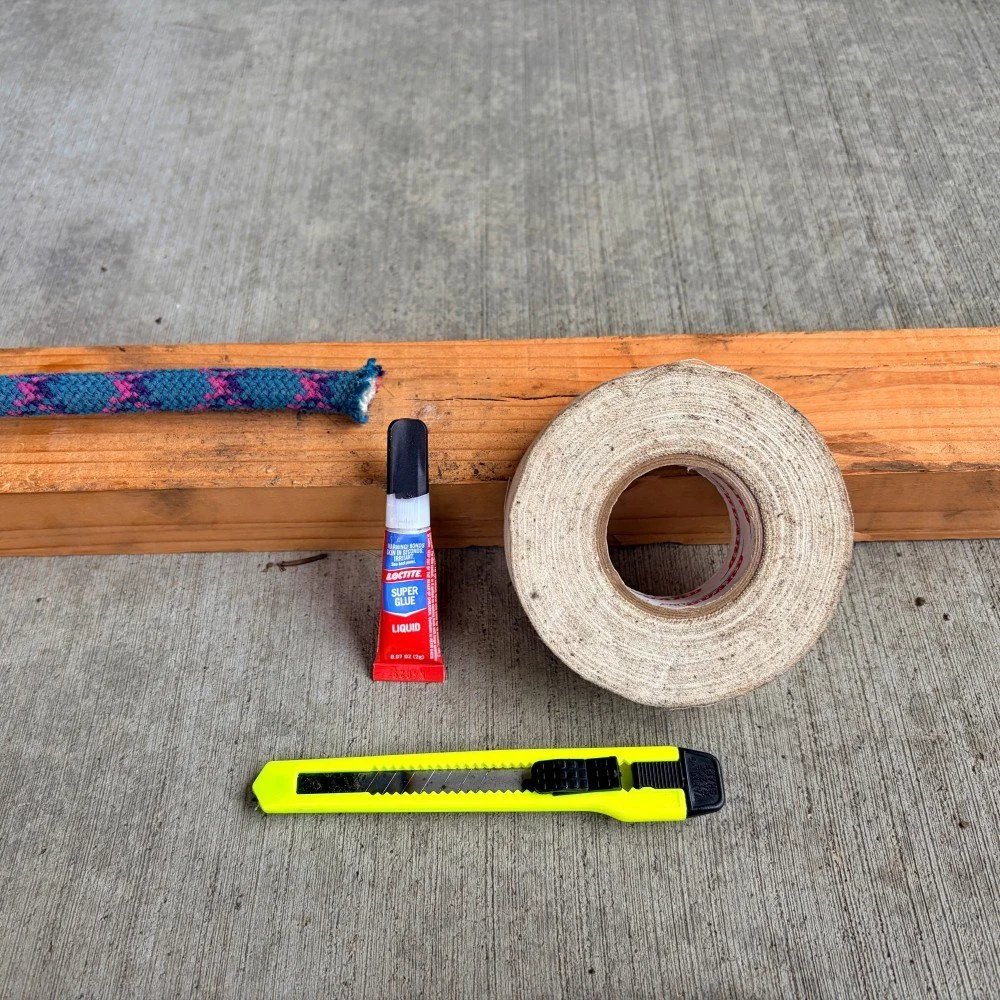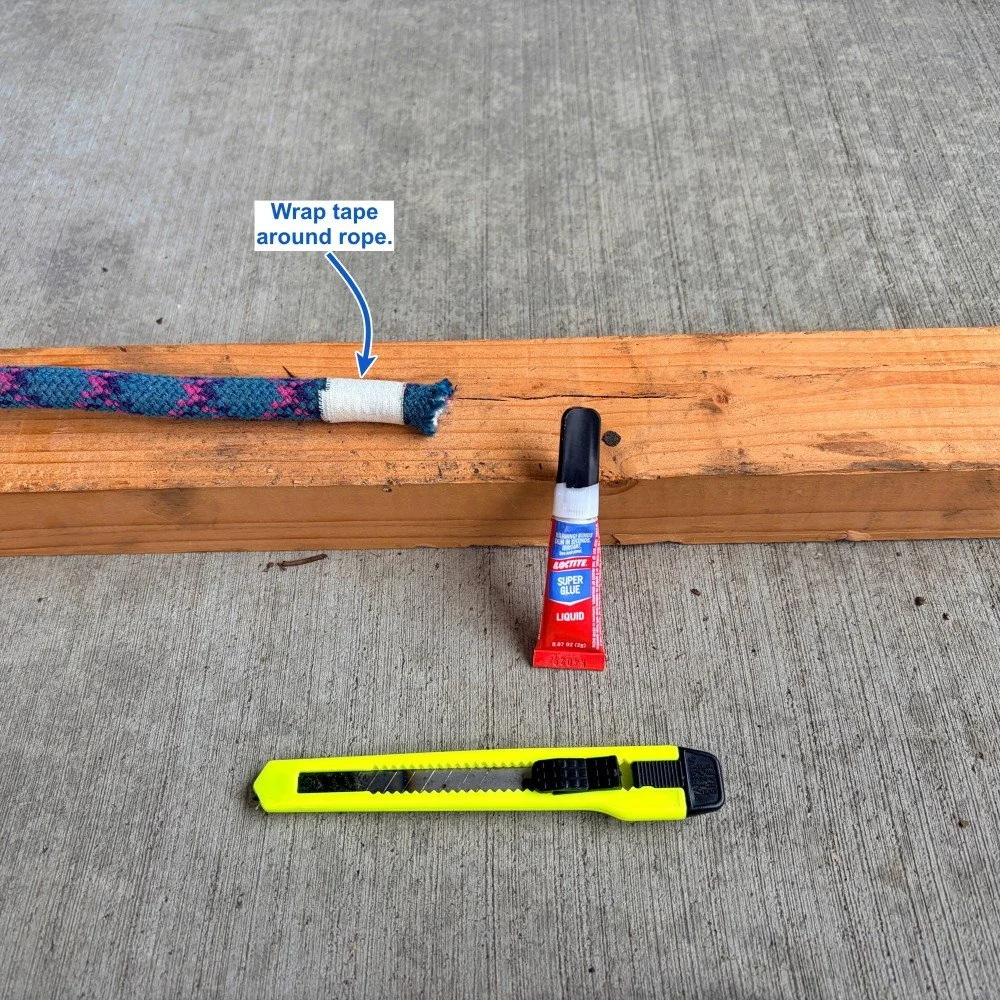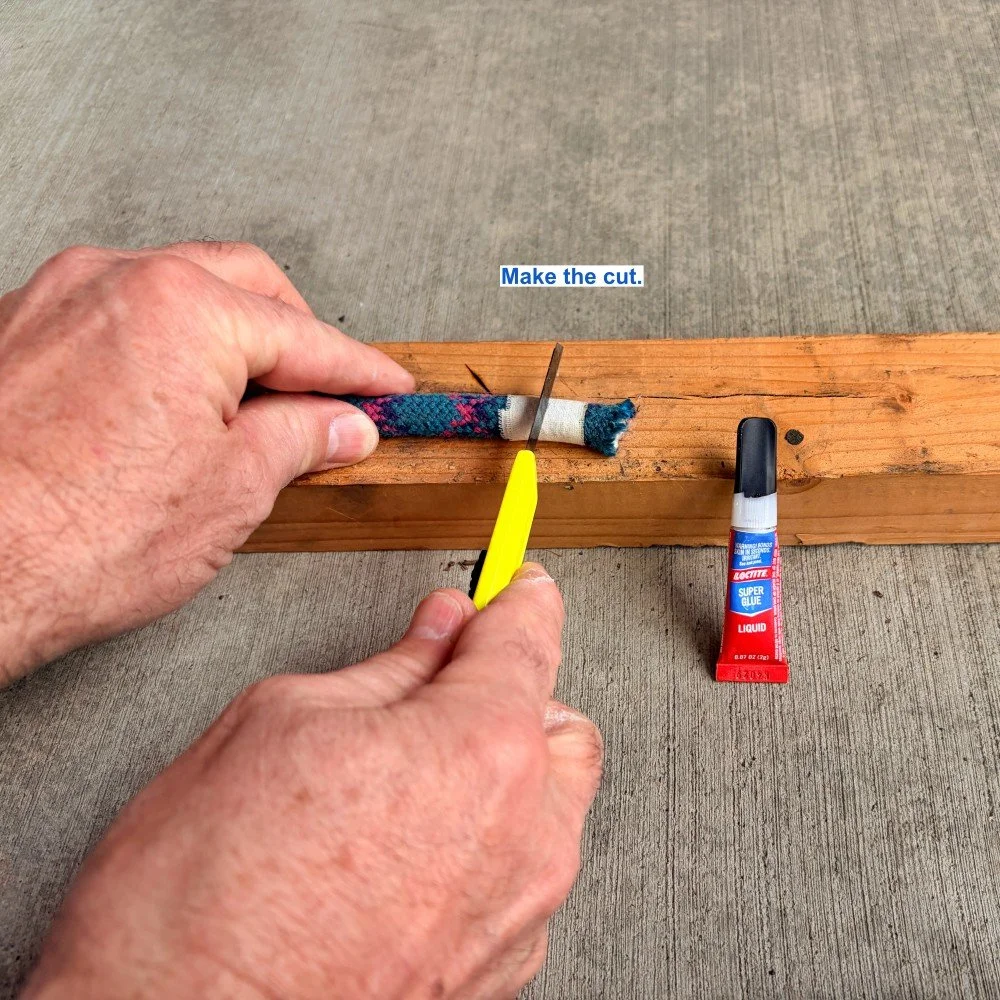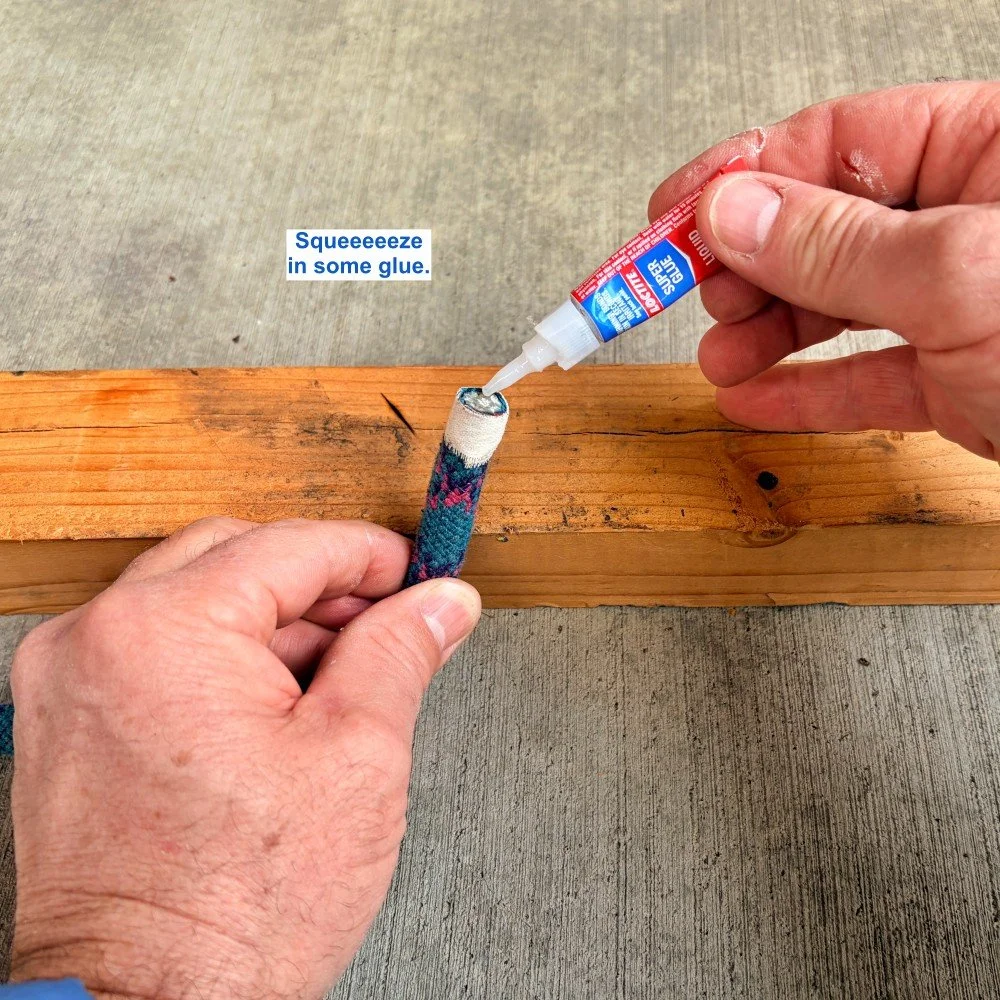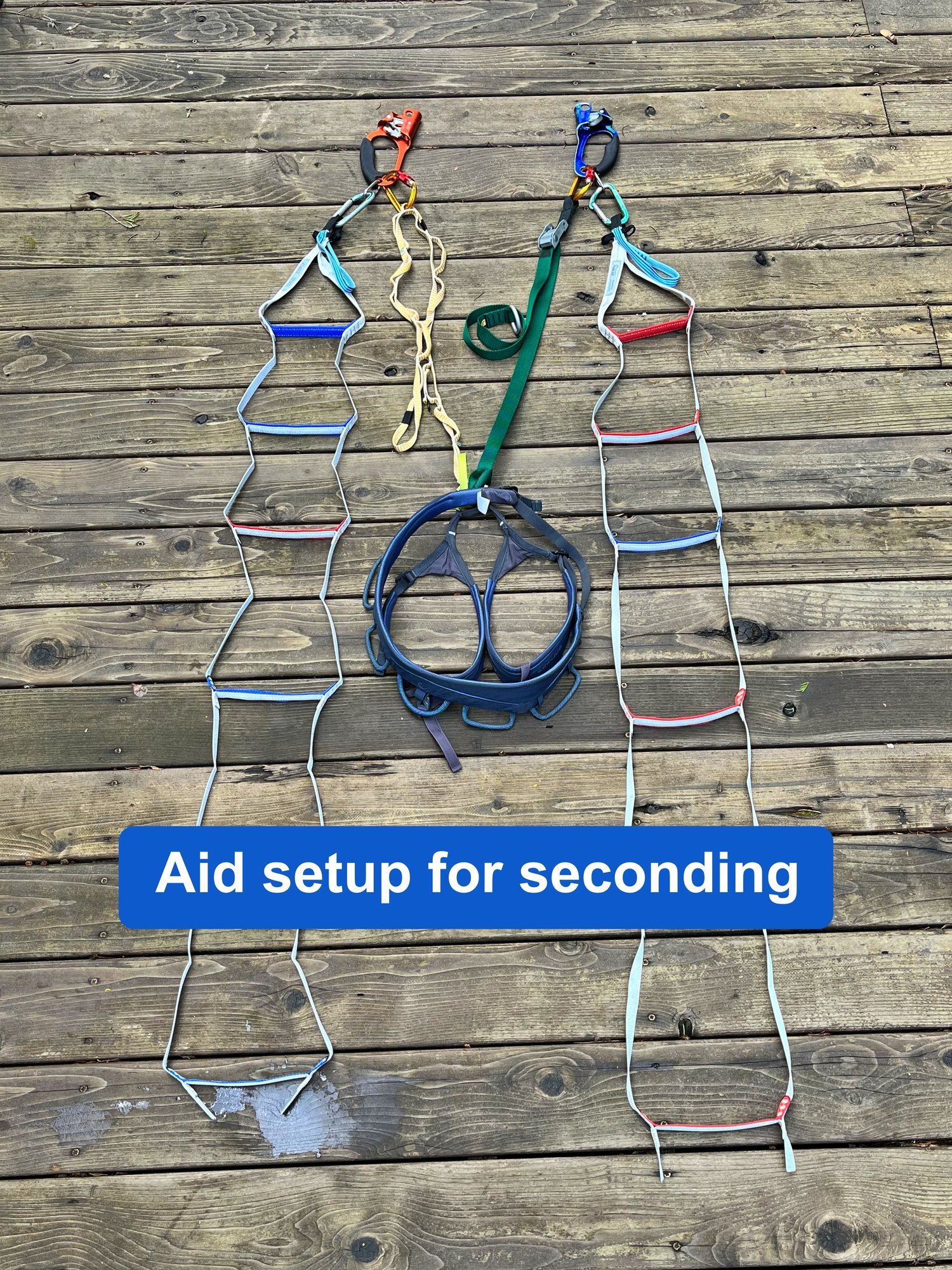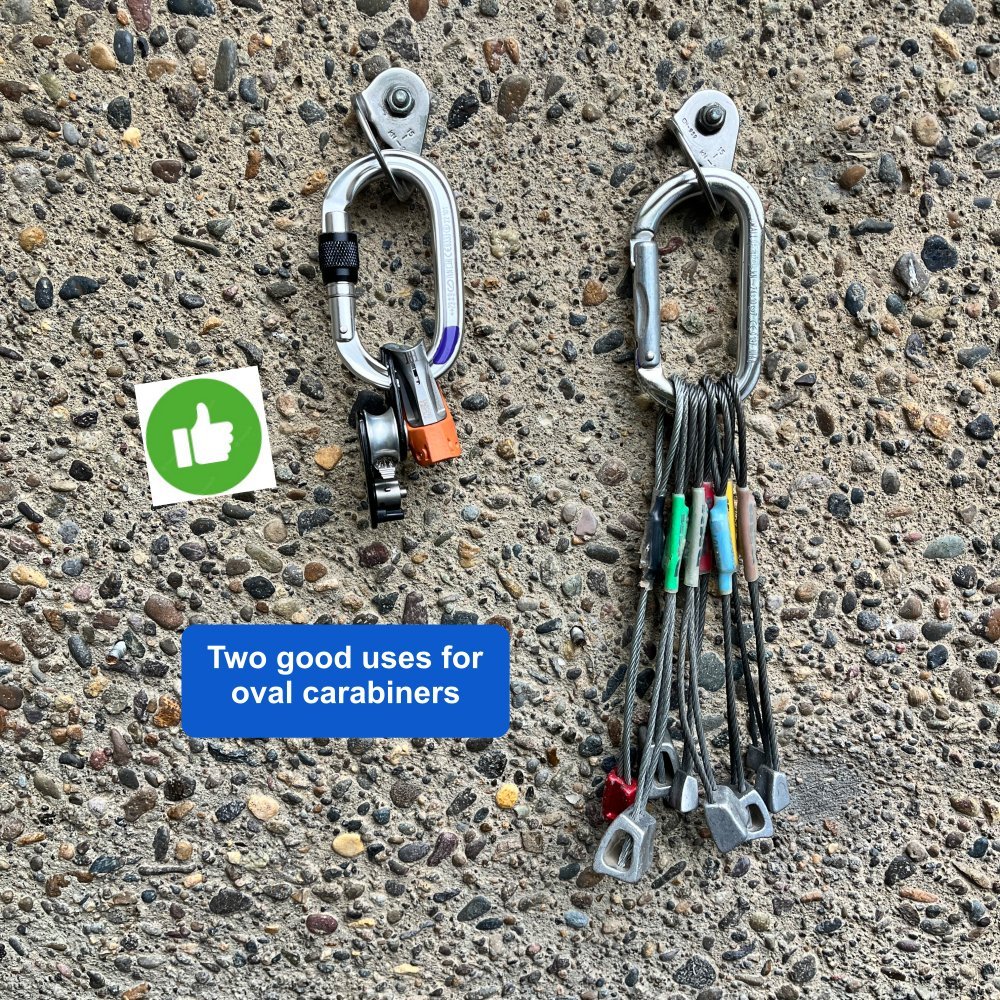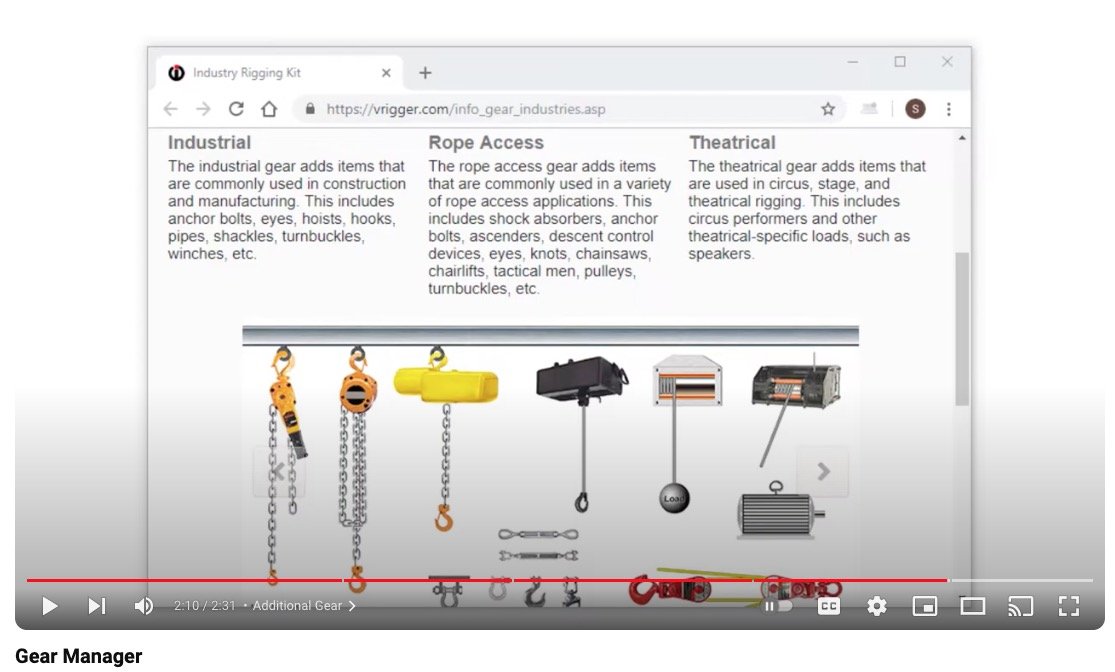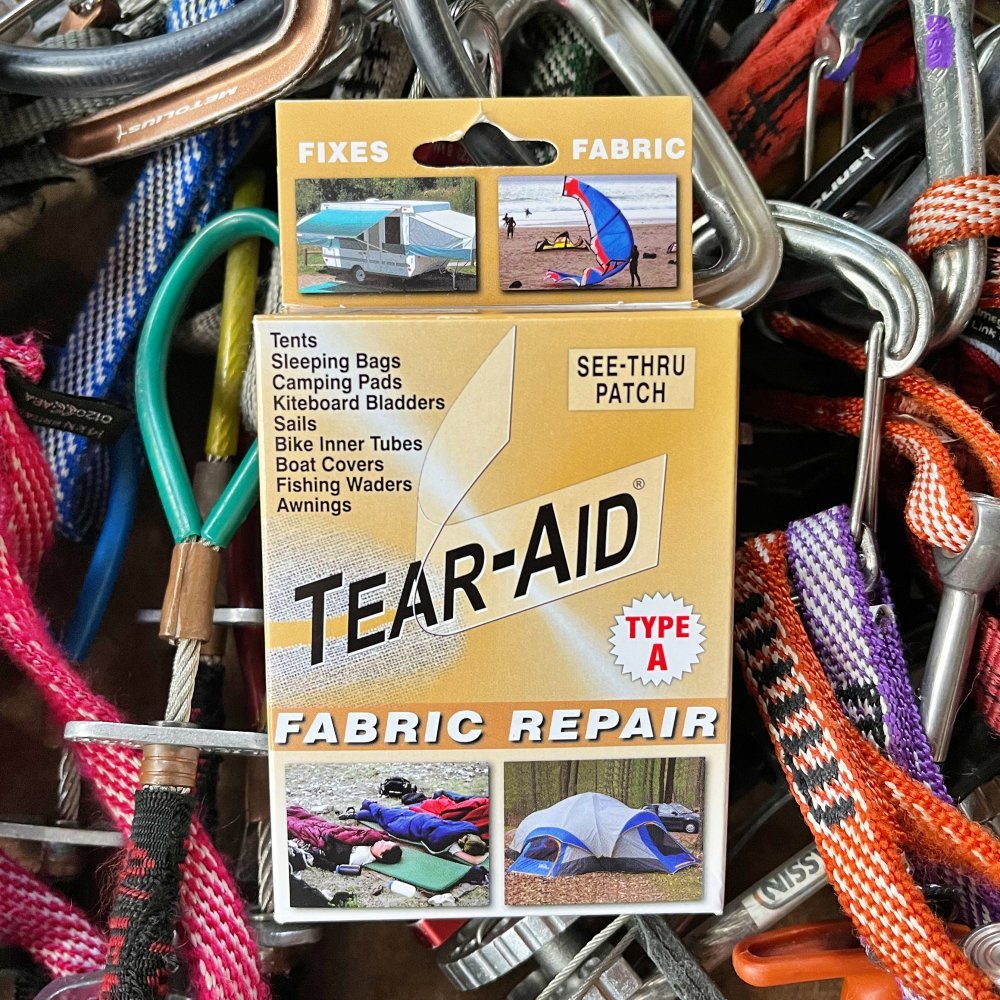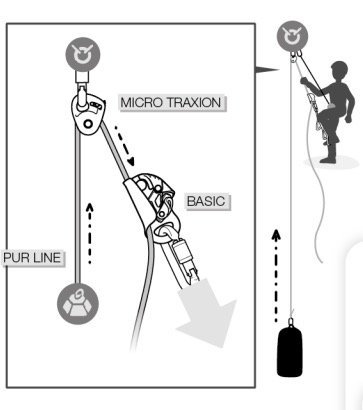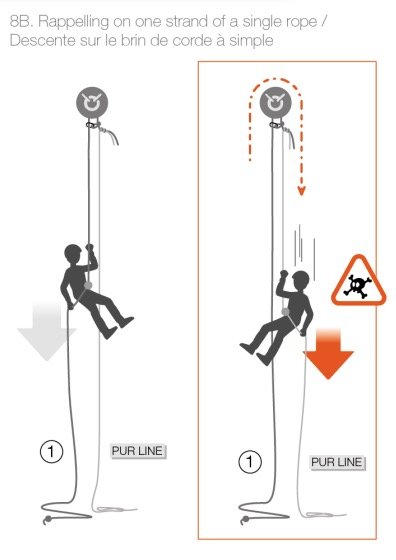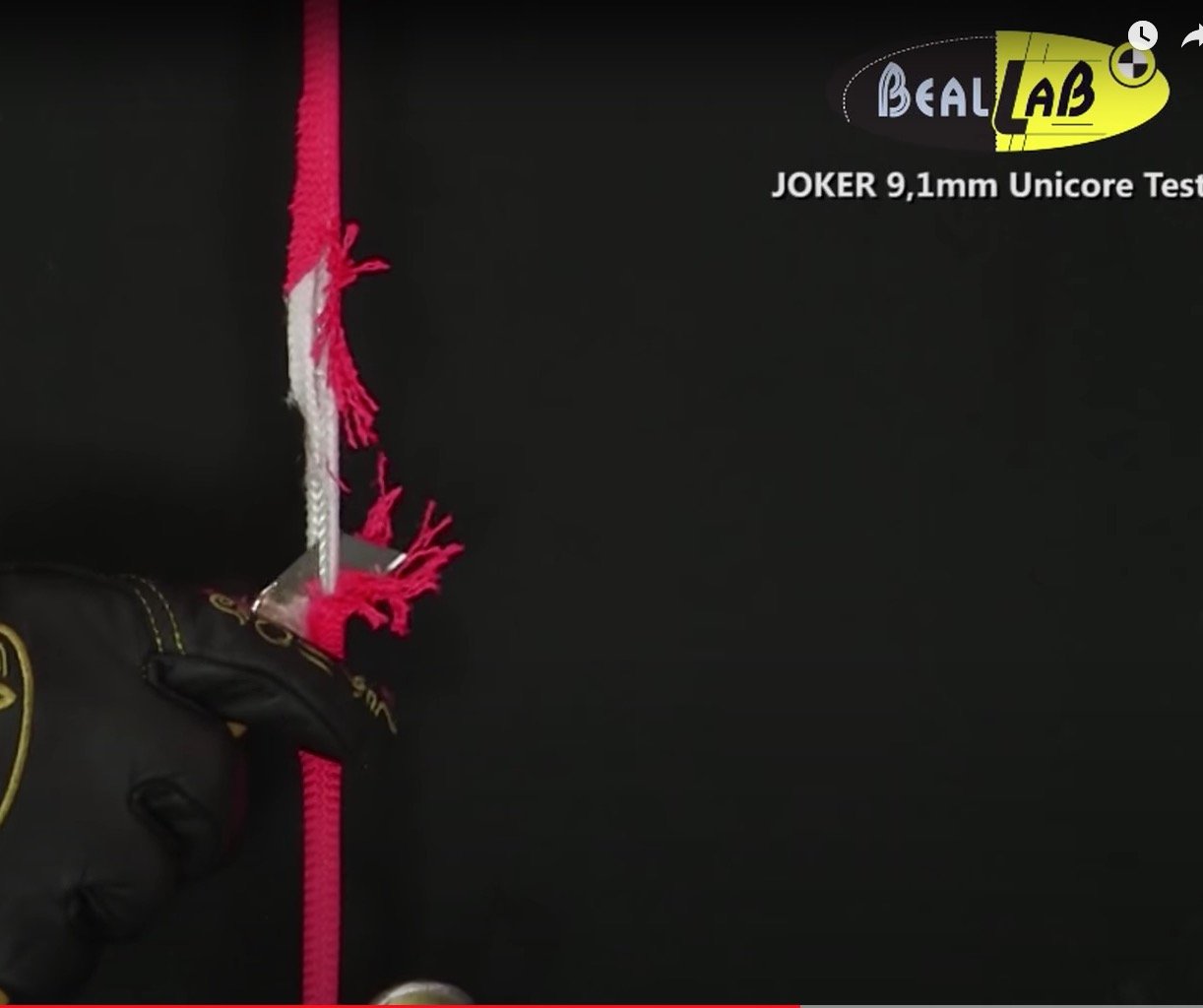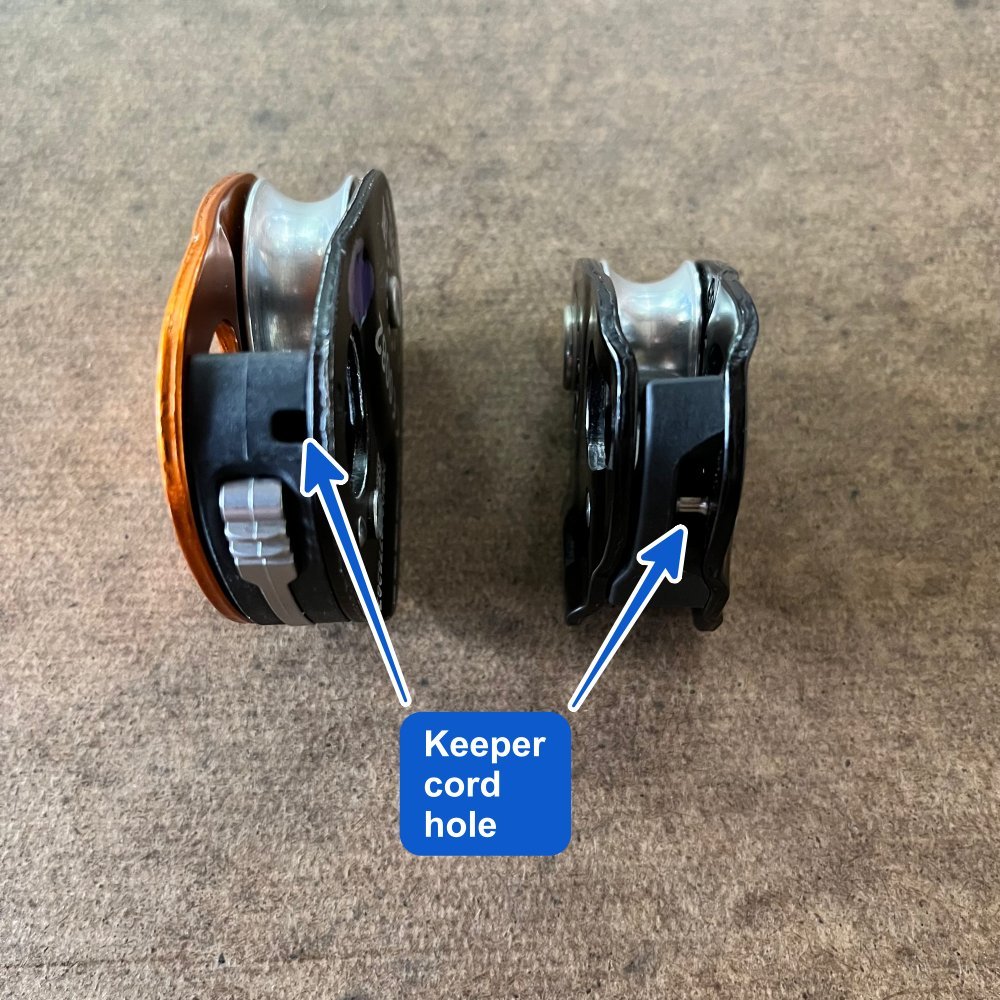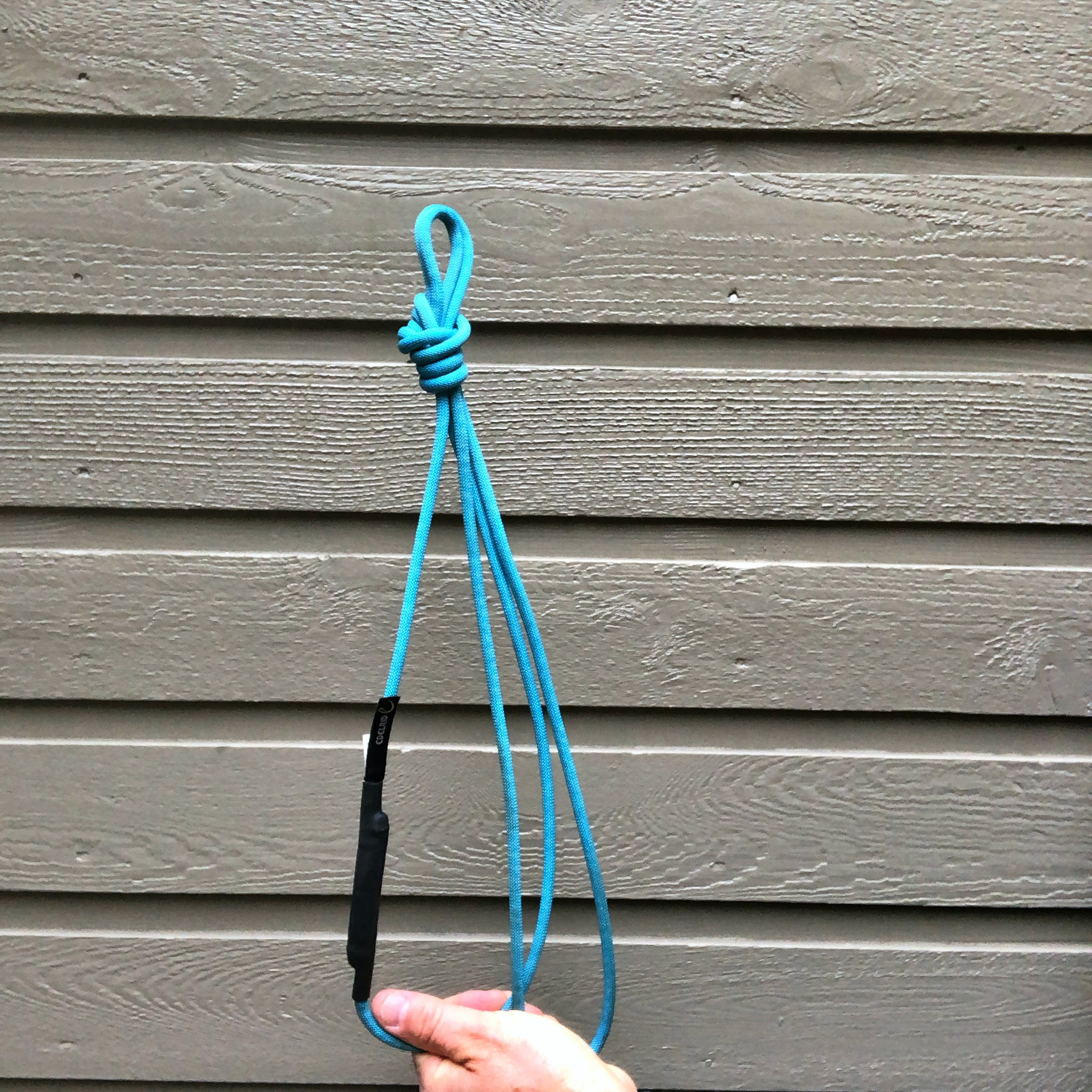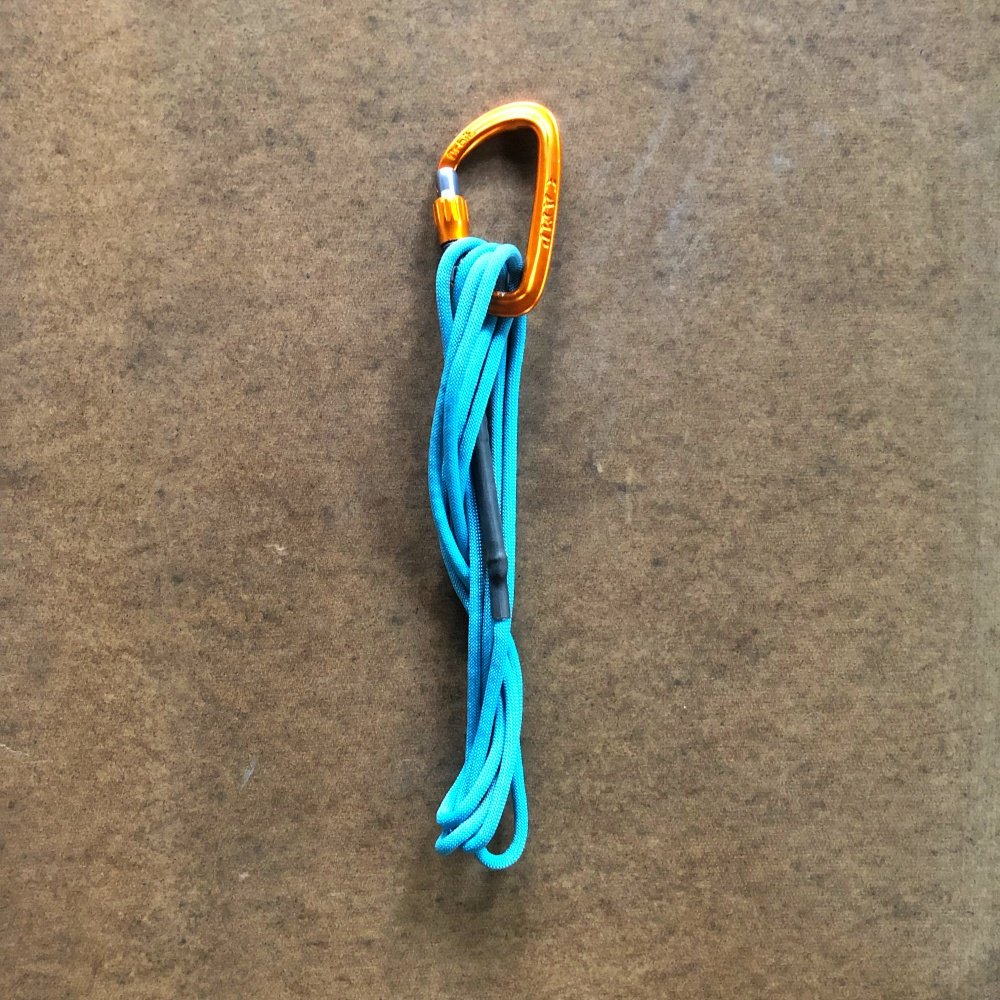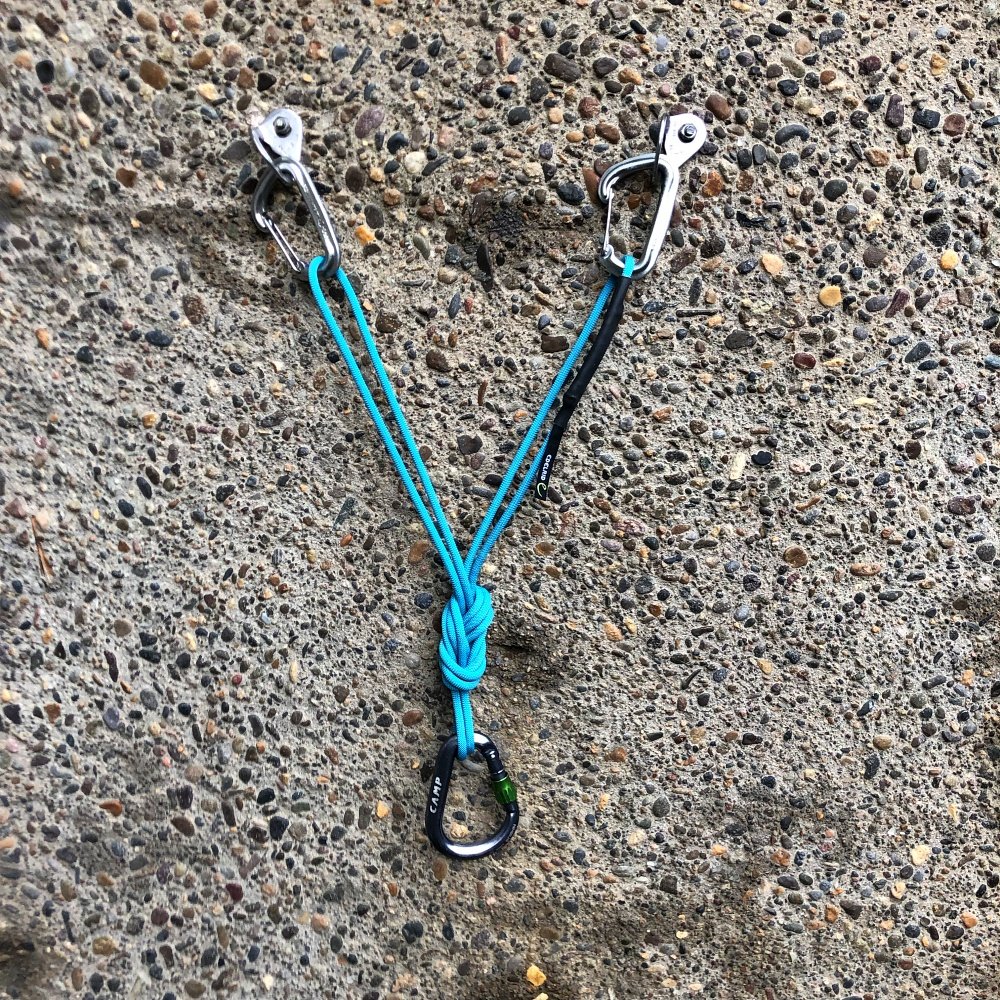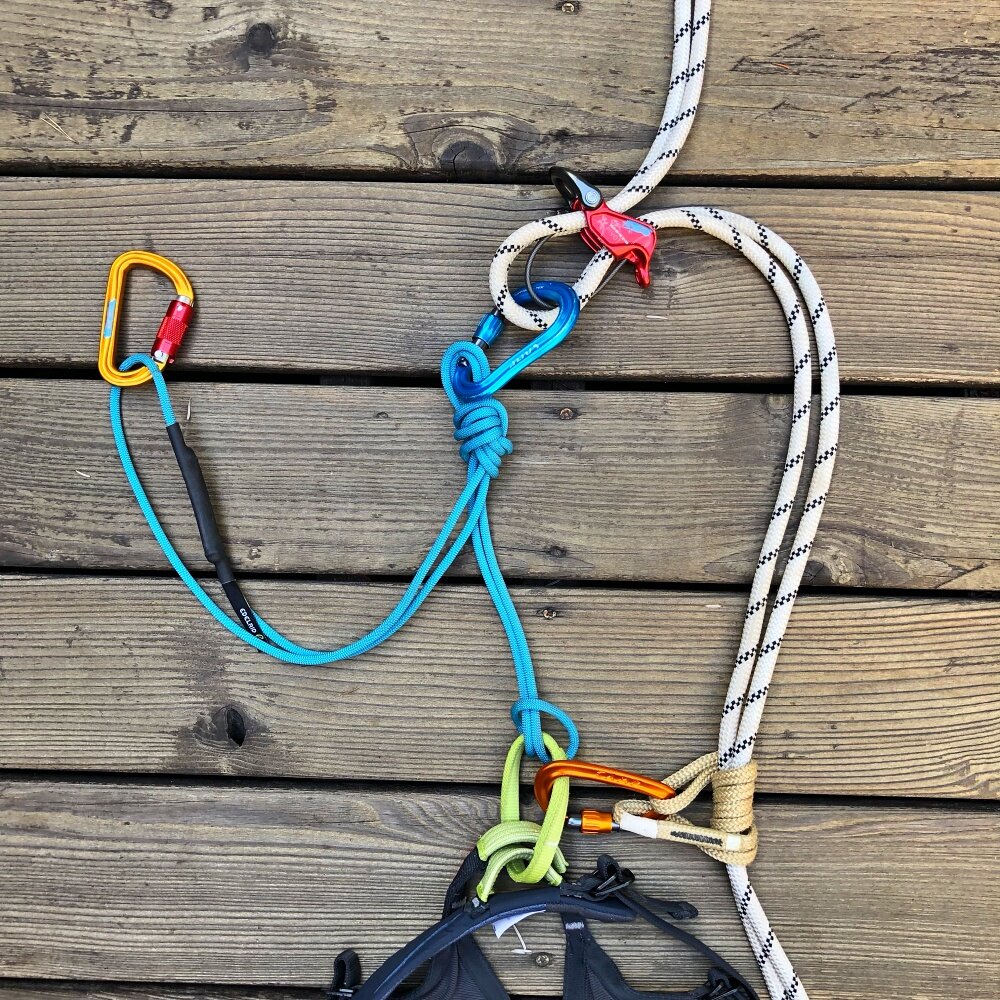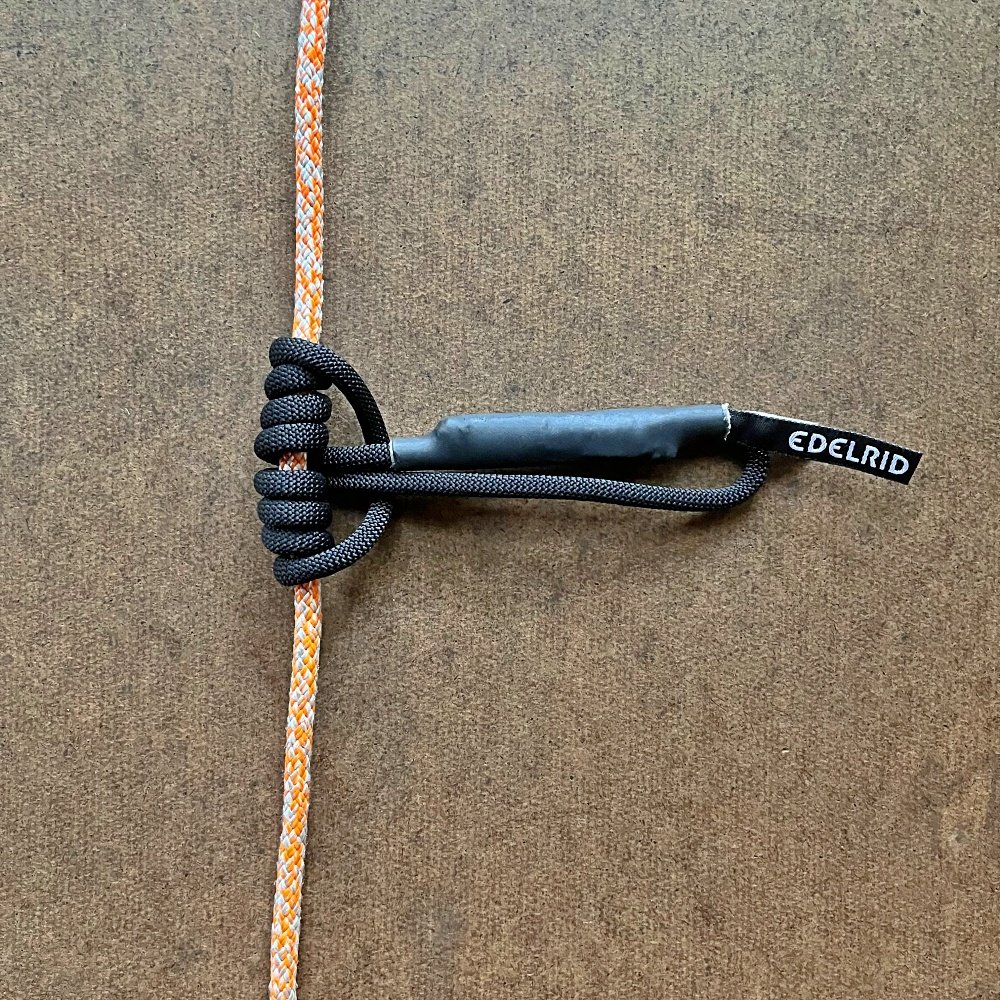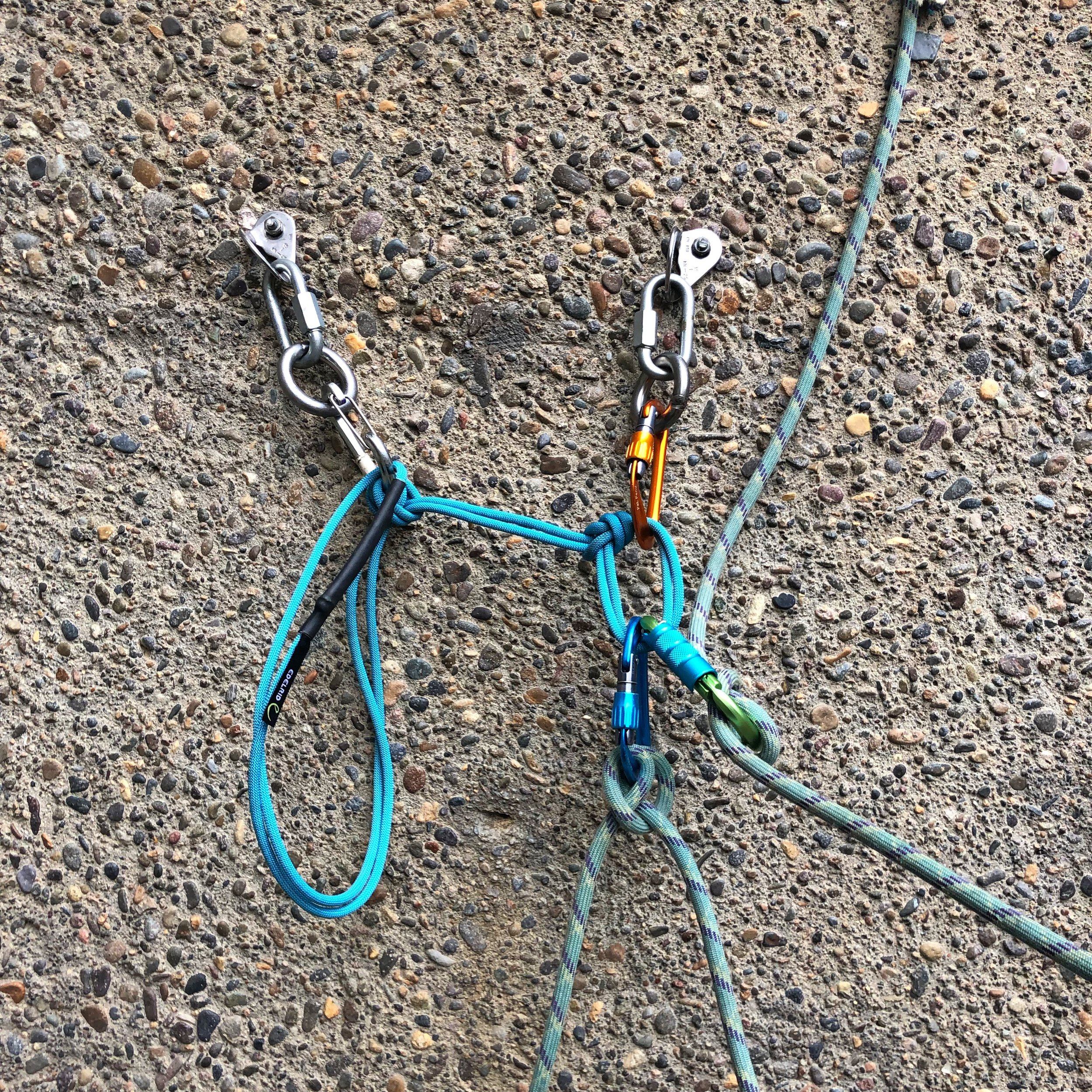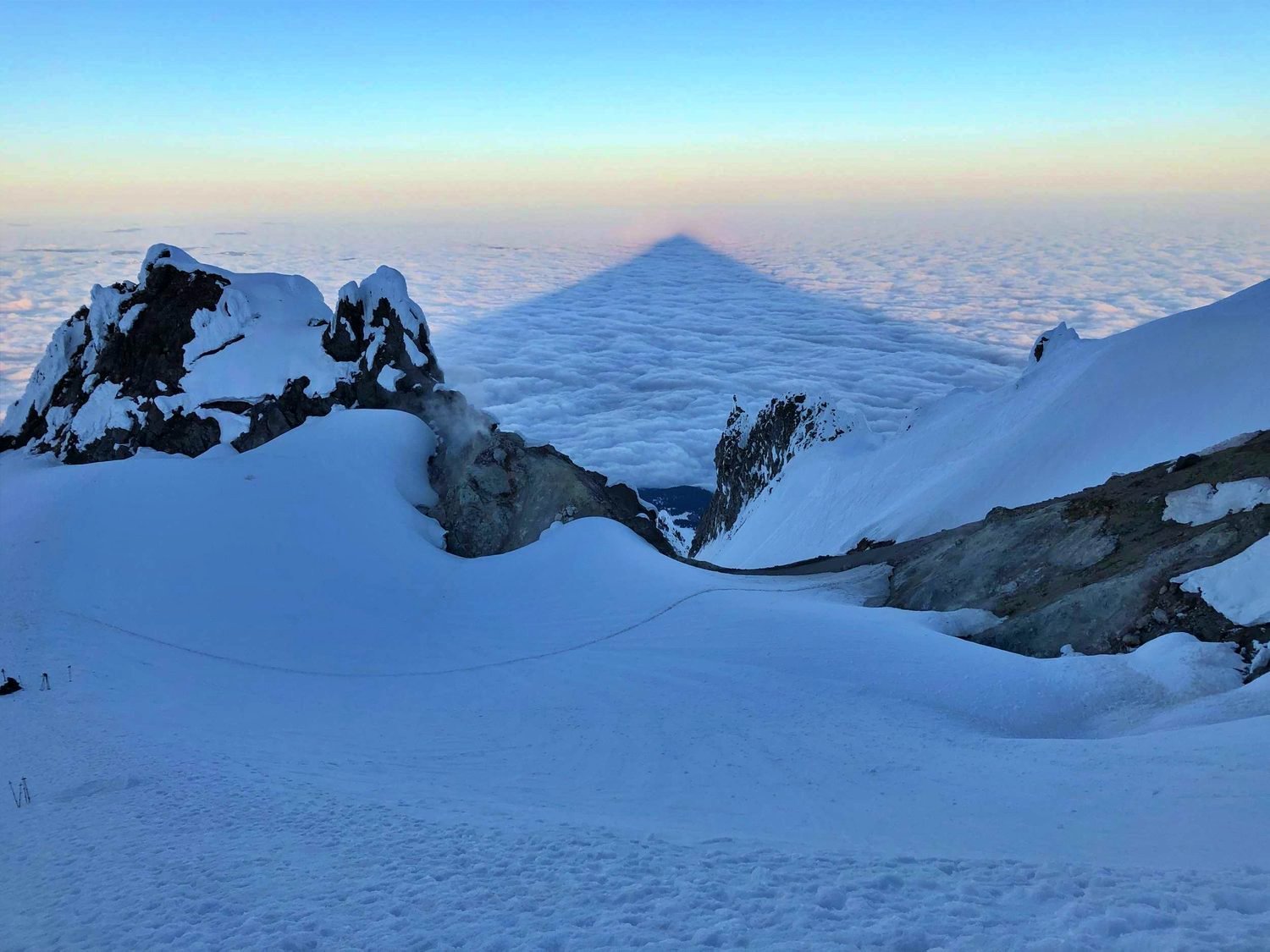
Alpine Tips
Two ways to (neatly) cut a rope
Yes, the electric hot knives in the climb shop work great. But I bet you don't have one in your garage when you need it. Here are two great ways to neatly cut a rope with simple tools and technique.
Premium Members can read the entire article here:
Sure, those nifty hot knife tools in the climbing shop are great. But if you need to cut a rope without one, and want a nice clean end, here are two ways to do it.
Rope cut method 1 - DIY hot knife
Notes:
Do this outside, nasty fumes are generated!
Wrapping with tape is the key move. This gives you a much cleaner cut.
Use a disposable utility knife, and NOT any sort of a good knife and especially one that’s ever going to touch food. The blade is going to have some discoloration and baked on melted rope yuckiness.
Stuff you need:
your rope (duh)
athletic tape
cheap utility knife with thin blade, get it at most any hardware store
piece of scrap wood
source of hot flame, like a camping stove or propane torch
Wrap a bit of tape tightly around the rope.
Heat up the knife blade in the flame. Orange hot is good.
Press / slice the hot knife down in the middle of the taped section. The hot knife should nicely melt through.
If needed, you can heat the knife up again and press the side of the blade against the cut end.
That's it! The end of your rope should be completely cauterized and ready to use.
Rope cut method 2 - Superglue
Notes:
Do this outside, and on a work surface you don't mind dribbling some glue on, because you probably will.
Important: the chemicals in superglue may not play nicely with most ropes. In this case we're using them only at the very END of the rope, which will never see a load. When you're doing this, be careful not to get glue on any other part of your rope.
Stuff you need:
your rope (duh)
athletic tape
sharp knife. Disposable utility or razor knife works well. Scissors generally don’t work well.
piece of scrap wood
Superglue
Wrap some tape tightly around the rope where you want to cut it.
Cut through the tape.
Holding the end of the rope vertically, scoooooge glue into the rope end, covering the core and the sheath.
Wait at least a minute before you take the tape off or you'll probably get some glue on your fingers, ask me how I know about this.
Sweet, give yourself a high five. You now have a perfectly sealed rope end.
What’s a common method used to cut and seal a rope that really doesn't work very well?
What's the best kind of superglue to use on ropes?
Which of these two methods should you use to cut an Aramid/Kevlar rope?
If you need to cut a lot of rope or webbing, what’s a low cost tool you can use to do this easily (that's not an expensive climbing shop rope cutter.)
Join my Premium Membership to read the rest of the article.
Thanks for your support!
Stirrups for rope ascending
Aid climbing requires lots of fixed rope ascending. The traditional way to do this is using your ”lead” ladders. However, an adjustable, comfortable and lightweight stirrup is a superior tool.
Premium Members can read the entire article here:
Back in the day, I saw a superb slideshow by big wall legend Hans Florine, holder of multiple speed records on El Capitan, about his vertical adventures. One was a video clip of him jumaring up a fixed rope at a ridiculous speed. It looked like he was jogging up a flight of stairs!
What was he standing in? Nothing more than a DIY stirrup of 1 inch webbing, with an overhand knot tied in each end. Clip one end to your ascender, make a sort of girth hitch out of the other end and cinch it down on your foot. Cheap, simple, efficient!
I may cover that DIY hack in a future article, but today, let’s look at a more refined tool that’s a lot more comfortable and adjustable - stirrups.
The ones I like: these sweet custom stirrups from Skot's Wall Gear.
Skot Richards is a big wall expert and one-man operation who sews everything himself from his shop in California. I like supporting his small business, innovative gear, and commitment to “Made in USA”, and I hope you do too.
(Skot was kind enough to send me these stirrups for review. In the rare cases I’m offered gear for a review like this, I’ll always tell you about it upfront. I only tell you about gear that I think is great, and never because I might get it for free.)
Almost ready to jug this rope.
(Not shown for clarity: two tethers connecting my harness and each ascender, see photo below. Those are important!)
Big wall ascending overview . . .
In big wall climbing, the rope is typically fixed by the leader and then ascended by the second, who cleans the gear.
There are three main components to a standard ascending system for big walls:
Two handled ascenders on the rope
Two tethers of some flavor, each attached an ascender with a locking carabiner
Two of something for you to stand in, which traditionally is your aid ladders
Here's a photo of the typical set up.
However, using your “leading” ladders for rope ascending has a few problems.
Main problem, your foot wants to wriggle out of the ladder every time you step up. Some ladders have a bit of elastic sewn underneath one of the bottom steps to try to deal with this, but that’s a bit of a bother. (Yes, once you get skilled at ascending, it’s easier to keep your foot in the ladder step, but it still is a bit of a balancing act.)
Especially on skinnier ladders with narrow steps, it's not so comfortable for your foot.
You can't fine-tune the height of the step for optimum efficiency.
The unused steps are flapping around below you, occasionally snagging on things and generally in the way.
The ladders are often heavier than necessary. This is especially true with some of the more robust, older style ladders. It may not seem like a lot of weight, but every time you slide that ascender up, you’re lifting the weight of the ladder. Multiplied by 3,000 times to get to the top of El Capitan, and that's a lot of weight.
A more modern way to ascend a rope: replace your aid ladders with a pair of dedicated foot loops, a.k.a. stirrup.
Stirrups solve all of the above issues:
They have a strap to lock your foot in place
The bottom of the stirrup has wider webbing, so it's more comfortable
They are easily adjustable, so you can fine tune the length
Nothing dangles down below your foot
They are lighter than your ladders
Bonus: relatively inexpensive, about $30 each.
Why does one stirrup need to be longer than the other?
What do you do with your lead ladders when you’re cleaning?
How do you dial in the all-important distance of the tether to your ascender?
Join my Premium Membership to read the rest of the article.
Thanks for your support!
How to cut an Aramid core rope
The normal way of cutting and melting a rope doesn't work too well with a rope with an aramid core, because it’s fireproof! Here's a simple and unconventional way to get a perfectly sealed cut on an aramid rope.
Premium Members can read the entire article here:
This tip comes from Australian rigging expert Richard Delaney. Connect with Richard on his excellent website Ropelab, Instagram, or his YouTube channel, where he has loads of concise, informative videos.
Yo! Disclaimer!
Important: the chemicals in superglue may not play nicely with most ropes. In this case we're using them only at the very END of the rope, which will never see a load. When you're doing this, be careful not to get glue on any other part of your rope.
(Aramid is the general term for a type of fiber. Kevlar and Technora are trade names for basically the same material.)
Need to cut and seal the ends of standard nylon rope or cord? The hot knife in every climbing shop works great.
But melting and cutting doesn’t work so well on Aramid core rope (such Sterling Powercord), because it’s fireproof!
Here’s a way to cut and seal an Aramid rope. (Works on regular climbing rope and cord too!)
What you need:
Tape. I used cloth athletic tape. Masking tape doesn’t hold very well.
Sharp, thin knife. Don’t use your favorite steel blade for this; it’ll dull fast. I used a tiny but very sharp ceramic knife. Razor blade works too.
Superglue. Cheap super glue have screw tops that don't work very well and the remaining glue is probably gonna dry out after you use it once. Name brand glue, like Loctite, have a much better quality, screw top, allowing you to reuse the glue. Spend a little more and get the good stuff.
Tip: Do this over a surface that you don't mind dripping superglue on! Ask me how I know this, and can't use my favorite green cutting board for food anymore . . .
1) Put a tight wrap of tape around the end of the rope. This helps make a clean cut.
2) Cut through the rope.
3) Smooooge some superglue into the fibers at the end.
There’s one last important step.
Join my Premium Membership to read the whole article.
Thanks for your support!
Can (or should) you resling cams yourself?
The webbing on your cam slings has a lifespan of about 10 years. What do you do then? Ideally, send it to the manufacturer for replacement, but that's not always possible. Here are some DIY options, and a list of all known places you can get replacement cam slings.
Premium Members can read the entire article here:
image: HowNOT2, https://www.youtube.com/watch?v=M19taMAZHp4
The generally accepted maximum lifespan of soft goods like nylon, Dyneema, and yes, slings on your cams, is around 10 years. If you use them heavily, it could be a lot less than that.
Reslinging a cam is not a money-making venture by the manufacturer or pretty much anybody else. Also, a manufacturer will almost always only resling their own cams.
If you live in the US, and a few places in Europe, getting this done by the factory is a possibility. But, if you’re outside this area (or if you live in Europe, and have cams made by Black Diamond) sending them directly to the manufacturer for sling replacement is probably not be cost effective.
So, what about replacing those cam slings yourself?
Here are some break test results of various DIY cam sling replacement options tested my friend Ryan Jenks, the mad scientist gear-breaking founder of HowNOT2.
(Disclaimer, these were tested on a limited number, your mileage may vary, if you want to be certain it's done right, then send ‘em back to the factory.)
Summary:
A 30 cm Dyneema sling doubled with a basket hitch is probably going to be your best bet. Be sure and clip both strands! Broke at 17.2 kN.
A 30 cm Dyneema sling tied in a double bowline on a bight also works. Broke between 10 and 13 kN, based on sling width. (Interestingly, the 8 mm sling tested stronger than the 11 mm sling.)
Avoid a girth hitch! Broke at 9 kN, and will probably mess up your cam. (Interestingly, it broke at 9-ish kN both on the slow pull and in the drop tower.)
Or, if you want to skip it entirely, cut off the sling and clip a short quick draw to it, good to go.
Cam reslinging companies
This information is current as of 2024. Of course, policies can change, so check before you mail anything.
If you know anyone who reslings cams who is not on this list, please email me so I can add them, thanks!
Gear companies:
Want to learn about other companies that resling cams:?
Join my Premium Membership to read the whole article.
Thanks for your support!
Petzl Traxion pulley comparison
What are some of the key differences and best uses for the Petzl Nano, Micro, Mini and Pro Traxion progress capture pulleys? Here's an overview of this very handy piece of gear.
Premium Members can read the entire article here:
Comparison of Petzl Traxion pulleys
Petzl makes a nice family of pulleys with the surname “Traxion”. They all share a few common design elements: a spring-loaded toothed cam that lets the rope (or device) move in one direction but not the other, and a high efficiency, sealed bearing steel pulley wheel (aka sheave).
Technically they are a “progress capture” pulley, which means when hauling a load, when you let go of the rope, the load doesn’t slide back down. That might sound like a one trick pony, but these little devices are helpful for lots more than just that!
You can use them as:
an ascender
a progress capture in any sort of hauling rigging
the rope grab in a mechanical advantage system
the “far end haul” for big walls
part of the set up for a Tyrolean traverse
top rope solo rope grab
belaying your partner from above (I don't recommend this! But I know people do it so I'll mention it.)
and more!
Here's a related article I wrote, comparing the Nano and the Mini.
A few Traxion tips . . .
It's best to use Traxions on an oval or HMS locker, and not a D shaped locker. Often with a D locker, the Traxion doesn’t hang straight down. With an oval or pear-shaped HMS locker, you usually get a nice vertical hang up the pulley.
When hauling, you can pre-thread the pulley onto the rope. Doing this lets you set it up faster and lowers the chance of you dropping it.
Traxions in a variety of sizes, prices, weights and best uses, so let's take a closer look . . .
Join my Premium Membership to read the whole article.
Thanks for your support!
The "Oh Sh*t kit"
If you carry some small and lightweight rescue gear, you can improvise just about any sort of hauling, rope ascending, or mechanical advantage system you might need to rig. Here's what I carry.
Premium Members can read the entire article here:
Some of the links on this page go to HowNot2.com. These are not affiliate marketing links. They are provided as a convenience to you. Your purchase supports the awesome gear testing YouTube channel HowNOT2.
Having a few basic tools to ascend a rope, set up a mechanical advantage haul system, or cut a rope / webbing is a great starting point for just about any sort of rescue scenario.
There are many items you could put in a kit like this. A frugal start is a couple of prusik loops and spare carabiners. But, having some dedicated gear offers greater efficiency and more options. Combine this rescue gear with a couple of 60 or 120 cm slings, or a cordelette, and you can do all kinds of rescue trickery!
For alpine climbing, here's what I usually carry:
Petzl Nano Traxion progress capture pulley
Petzl Tibloc rope grab
Sterling friction hitch (Hollowblock, or shown here, 6 mm autoblock cord)
Tiny hardware store cheapo lockblade knife, with tape wrapped around it to prevent it from opening accidentally, and a short clip-in loop attached. If you want a better knife, check out the Trango Piranha or the Petzl Spatha
All conveniently racked on an oval locker
The knife is used to remove sun-bleached ancient crusty webbing from rap anchors (hopefully replaced with new material by you), to cut a cordelette for rap anchor material, and if needed, to cut away something under tension in some sort of awful rescue rescue scenario where it might be your least-worst option. (See the classic Joe Simpson book “Touching the Void” for an epic story about this very thing.)
Want to learn a few more uses for this gear?
Join my Premium Membership to read the whole article.
Thanks for your support!
Snag-free screw storage with the Ice Screw Cannon
Looking for a convenient, bulletproof, snag-free and made-in-USA way to store your ice screws? Check out the Screw Cannon from High Mountain Gear.
Premium Members can read the entire article here:
Do you want a way to carry ice screws that’s lightweight, super-strong, convenient, snag free, sourced and made in the USA, and doubles as a gear stuff sack?
Look no further than the Ice Screw Cannon by High Mountain Gear.
The Screw Cannon organizes and provides easy access to ice screws. It has a unique tapered and offset tube design for snag-free storage, capacity for 12+ or 14+ screws, and is made from super durable, waterproof recycled sailcloth. Weight: 3.7 oz / 105g for the small) and 5.0 oz / 142g for the large.
High Mountain Gear has a clever accessory to increase the capacity of the screw cannon. Want to learn about it?
Join my Premium Membership to read the whole article.
Thanks for your support!
What are oval carabiners good for?
Do you think oval carabiners look chunky and old school? Well maybe, if that’s your entire rack. But, for some specialized uses, they still deserve a place on your harness.
Premium Members can read the entire article here:
image: from climbing historian and big wall ace John Middendorf’s outstanding website of historical climbing gear, https://www.bigwallgear.com/p/first-carabiners-for-climbing-summary
An oval carabiner was the first shape that was widely available to modern recreational climbers. However, carabiner design has changed a lot over the years, and now we have LOTS of different styles.
Does that mean the oval is obsolete? Nope! They’re great in certain applications.
Why are oval carabiners useful?
Behaves nicely with boxy devices like a Petzl Tibloc or Micro Traxion, or a fixed gate pulley
Perfect for racking stoppers. The stoppers rotate nicely around the oval end, and don't get jammed up like they can on a D shaped carabiner.
Works well with a Grigri and other types of assisted braking devices (ABDs), generally avoiding cross loading.
Tie a Munter hitch on them, and the hitch flips nicely back-and-forth. (That's right, you don't need a pear-shaped HMS carabiner for a Munter hitch.)
Rotates through loaded anchors, pitons, clove hitches, and other attachment points; doing this can be a problem with some D / asymmetric carabiners.
If ovals are three-way loaded, they retain almost full strength, (tested up to about a 60 degree angle), see video below.
Great for aid climbing, when you often have more than one carabiner clipped to another.
Works nicely as a top rope master point, using three snapgate ovals opposite and opposed. Functionally the same as two lockers, gives a nice smooth lower, and maybe puts the wear and tear on less expensive ovals instead of your more $$ locking carabiners. Here's how to set that up.
Reasonably lightweight; about 60 grams.
Fairly inexpensive, compared to other specialized lockers.
Want to learn a few more ways to use ovals?
Join my Premium Membership to read the whole article.
Thanks for your support!
vRigger - Rope rigging software
Calling all rope nerds and gear heads: check out vRigger! It’s specialized and very cool software that lets you design, test, and teach rope rigging. Here’s an overview of how it works, and a discount code when you’re ready to try it yourself.
Full disclosure: vRigger sent me this software for free. That in no way biases my review; it's a cool product and I want to tell you about it. There are no ads, affiliate marketing or paid product promotions on Alpinesavvy. When I get a free product like this, I’ll always let you know.
vRigger offers a 10% discount to Alpinesavvy Premium Members. Learn about Premium Membership here.
What’s vRigger? Very cool Windows software that lets you design, teach, and test rope rigging.
It may appear that it's a drawing program. But the real power under the hood is the ability to specify load and pulling forces to see how your system actually behaves in the real world.
They have a nice series of tutorial videos showing how to use every part of the software.
The “Getting Started” video is a good overview, to see if it's right for you.
I use vRigger in two main ways:
Setting up different mechanical advantage hauling systems to see the efficiency and forces anywhere in the system.
General purpose drawing and diagrams relating to rigging.
You can insert carabiners, pulleys, rope grabs, friction hitches, etc. to build just about any kind of rigging or hauling system you can dream of. They have a large “library” of pretty much every sort of rigging device available. (And, if they don't have the exact piece that you need, you can create it yourself.)
Drag one component on top of another, and they auto-magically snap together to build your system.
For example, here's a diagram that I made for an article on the three types of mechanical advantage (illustrating that a theoretical 2:1 will always be less in the real world, because of friction, rope stretch, and other hard to quantify variables.)
This shows the difference in efficiency in a 2:1 haul system, between using a pulley on the left and a carabiner on the right.
After you specify the weight of the load (here 100 kg, you can use ‘Merican freedom units as well) it automatically calculates the forces involved all throughout the system, depending on the rigging and load! Cool!
An interesting take away from this diagram: using a lower friction pulley is more efficient to move the load, but it also puts a higher load on the anchor. It's one thing to read about this in a theoretical way; it's another to see the actual numbers like this.
Here's something all climbers should know about: how changing the angles of your anchor “arms” can change forces on the anchor. These numbers dynamically update and change as you click and drag the anchor around.
Hint, you should never build a climbing anchor like this! You can see that there's no more load sharing, but in fact load magnification. If you ever make a Tyrolean traverse, be sure the anchors on either side are unquestionably strong, because they're gonna get a big load!
image: https://www.youtube.com/watch?v=CRxd2NPDpcw
It’s not all engineering stuff. You can make more general purpose diagrams like this. Click and drag on the points and lines to create bends in the rope.
image: https://www.youtube.com/watch?v=gWBWtQzHwQc
There is a very convenient section of “sample files”, which are essentially premade diagrams for common rigging. This is a big timesaver. Here's an example, some typical mechanical advantage set ups.
There are even gear libraries for specialized applications such as industrial, rope access and theatrical.
So, that's a quick overview of vRigger. While I’m only using a small portion of the capabilities, hopefully you get a sense of how helpful is it for visualizing, drawing, and determining forces of different rigging systems.
If you want it yourself, use the discount code “AlpineSavvy” when ordering for a 10% discount.
My favorite mini headlamp - the Petzl Bindi
Headlamp technology keeps getting more ridiculously amazing, with lighter weight, brighter bulbs, and better design. While for climbing having something with 500 or more lumen output is really nice, there's also a place in your pack (and around the house) for a headlamp with more modest specs and lower cost. My new favorite: the Petzl Bindi.
Full disclosure: Petzl sent me this for free. It replaces a Bindi that I bought that decided to go for a walk. That in no way biases my review; it's a cool product and I want to tell you about it. There are paid product promotions on Alpinesavvy. In the rare cases when I get a free product like this, I’ll always let you know.
Modern headlamp technology is ridiculously awesome, and there's basically zero excuses to not have one as part of your everyday carry kit at pretty much all times.
Petzl and Black Diamond have been duking it out in the headlamp arena for a very long time, and we, the lucky customers, benefit.
For mountaineering, or longer trips in colder weather, you probably want a headlamp with a larger battery and a minimum 500 lumens, like the Petzl IKO Core, or the 900(!) lumen Petzl Swift. But for more general purpose hiking, 10 essentials, dog walking, everyday carry type stuff, a headlamp that's lighter, less expensive, with less light output works just fine - like the Petzl Bindi.
Here's why the Petzl Bindi is my favorite mini headlamp:
A ridiculously light 35 grams.
Minimalist elastic cord headband, yet still comfortable and functional.
Three main light levels: low, medium, and high (high is 200 lumens).
Red light for maintaining night vision and not blinding your friends.
Flashing red strobe light for increased visibility (and signaling, I suppose).
Rechargeable battery via micro USB port. (Yes USB C would prolly be better . . .)
Battery indicator light flashes for a few seconds after you turn it off to show the approximate battery level, very handy.
Reasonably weatherproof for hiking in the rain, but not for scuba diving.
Two different ways to lock the switch so you avoid accidentally turning it on in your pack.
Superbly engineered gear, at a fair price of around $45. I think that this (or something like it) belongs in the pack of just about everybody pretty much all the time.
Another option from Petzl that's even lighter and less expensive, but with a lot lower light output, is the e+LITE. (Personally, I like to have the option of the 200 lumens when I need it, so the Bindi recently replaced my much older eLITE.)
Reminder, there are no paid product promotion or affiliate marketing links on our Alpinesavvy. I occasionally share gear that I think is great, and there's no financial benefit to me when I do so.
Try “Tear-Aid” tape for fast, easy gear repair
Got a rip in your tent fly, gaiter, backpack, or any kind of clothing? How about a puncture in your inflatable sleeping pad? Hope you brought some Tear-Aid tape in your repair kit.
Did you rip your inflatable sleeping pad, tent fly, jacket, etc in the backcountry? Pretty hard to fix those without some repair tape. (And no, duct tape is not the best.)
High-quality tape that has some sort of backing material on it is usually better than duct/gorilla tape for fabric repair. The backing lets you cut off a small square to carry with you, rather than a big roll, and improves the chances of the adhesive working properly after a long time in storage. (That's the problem with the old trick of wrapping some duct tape around the handles of your trekking poles or ice axe; the tape is going to be in pretty sorry shape when you someday need to use it.)
I've used LOTS of different brands over the years. My new favorite: Tear-Aid.
Tear-Aid tape works great for patching and fixing most any kind of outdoor fabric. This includes inflatable sleeping pads, which can be tricky to patch. I’ve used it to fix a tent fly, hole in a puffy jacket, and a rip in the fabric of my pop top Volkswagon camper van.
Tear-Aid comes in two different flavors, “Type A” and “Type B.” Get Type A for general purpose repair. (Type B is meant for vinyl only. If you do whitewater rafting, Type B in the repair kit is an excellent choice.)
It comes in a roll 3” wide by 12“ long (plus a pair of smaller pre-cut squares and rubbing alcohol pads) and cost about $10. Yes, that’s expensive, but to me that's a good thing. Quality over quantity! This is still more tape than you would probably need for a long time, so divide it up and share the cost with some of your pals.
How does it compare with Tenacious Tape? Tear Aid is better - stronger adhesive, and much more flexible.
To use it:
Cut a patch with scissors about an inch or so larger than the area you need to repair.
Round off the corners with scissors, so the patch is oval-shaped.
Clean the area with rubbing alcohol, if you have it. (Pro tip: after you wipe off the area with rubbing alcohol, give it a good 15 minutes to completely dry. This can give much better adhesion on some surfaces.)
Carefully peel away about half of the backing material. Center the middle of the exposed sticky part over the fabric, start smoothing it down, and then pull the remainder of the backing tape off. Important! don’t touch the sticky part with your grubby fingers!
Press the tape firmly into the fabric, trying to remove all wrinkles and air bubbles.
from the Tear-Aid website:
“TEAR-AID® Repair Patches provide a simple and easy method of patching holes and tears, as well as an excellent protective film solution. Each TEAR-AID® Repair Patch is made from an exceptionally tough, matte finish, abrasion resistant, elastomer that resists puncture and tearing. It is combined with an aggressive adhesive formulated for high bond strength. Tear-Aid expands absorbing force on impact and always returns to original shape and size. This flexibility allows the patch to conform to irregular surfaces without restricting the movement of the repaired material.”
You can get it online, or at least in my corner of the US, at a local Ace hardware store.
Here's a video showing the simple repair process.
Petzl - RADline vs PURline comparison
Petzl makes two highly specialized ropes suitable for alpine climbers, the RADline and the PURline. Both have a static Dyneema core, both are 6 mm, and both are designed for different applications. Here's just about everything you need to know about these ropes.
Petzl offers two flavors of highly specialized ropes for alpine climbers: the RADline and the PURline.
What's with the acronyms?
Can I lead climb on ‘em? (Quick answer, NO!)
Are they both basically the same thing?
Can I really use a 6 mm rope for something practical, or is this a dog leash?
They both have a lot of similarities and some important differences, so let's get into it.
Similarities of RADline and PURline
Both are hyperstatic (just 2% stretch!) and NOT meant for lead climbing.
Both are 6 mm.
Both have a core of HMPE (High Modulus Polyethylene), commonly known as Dyneema. This makes them very strong (12 kN RADline, 15 kN PURline) and cut resistant.
Because of the HMPE core, these ropes absorb essentially zero water, so they're much lighter when dragging through the snow.
Both have a sheath that’s bonded to the core, which means you can use them for hauling with ascenders, such as a Tibloc, Micro/Nano Traxion progress capture pulleys, and even larger ascenders, see diagram.
The ascender/pulley compatibility may be confusing, because the technical documentation for the Tibloc and Traxions specify a minimum rope diameter of 8 mm. Apparently it's fine to use these devices on these 6mm lines. Petzl says that these ropes can take about a 4 kN load with these devices before the sheath will be damaged. See Petzl test results on this here. (Summary: Use a Traxion on RADline only.)
Because of the small diameter, both are highly prone to tangling. Using some sort of rope bag is highly recommended. If you don't have a rope bag, coiling it with a daisy chain (aka chain Sinnet or crochet) works pretty well too. If you tie the bottom end of the rope to your rope bag, you can toss it for rappel and quickly deploy the rope perfectly, even in high winds.
A basic nylon stuff sack works okay as a rope bag. However, it’s difficult to stuff the rope in a floppy bag. Here I’m using an ice screw bag made by High Mountain Gear. It's the perfect size, has a lid that stays open for rope stuffing, has a couple of attachment points, is extremely sturdy, and works great as rope bag.
RADline details
Intended use: crevasse rescue, glacier travel and rappelling.
Made for “Rescue And Descent”, hence the name.
Static ropes can be great for glacier travel, provided you have excellent rope management, i.e., minimal slack. Because it's static, the distance of any fall will be minimized - less rope stretch. On the downside, because it's static, if the people on top have extra slack out, it can give them a powerful yank. If using this rope for glacier travel, be very mindful of distance between partners and watch your slack.
Weight: 22 grams per meter (about half the weight of an 8mm dynamic rope)
It has a rougher sheath for better handling, more friction on ice and snow when arresting falls, and for extra friction when rappelling.
It's a bit more supple, which makes it a bit easier to handle and to stuff into your pack.
It's orange, which gives better contrast on snow.
Rappelling on this is easier than the PURline, but still can be challenging because of the small diameter. Definitely learn some techniques to increase friction, such as shown in this article. You also use specialized rappel devices made for small diameter ropes such as the Black Diamond ATC Alpine guide, Grivel Scream, or the Edelrid Mago 8 (see below).
I tested using an 6mm Edelrid Aramid cord as a four wrap prusik on both ropes. This held my body weight on the RADline, and not on the more slippery PURline. A Tibloc may be better choice than a prusik on rope this thin.
Comes in lengths of 30 and 60 meters.
Supposedly has a 10 year rated lifespan, which is longer than the typical dynamic rope.
Sorry, no nice diagrams from Petzl. =^(
The Grivel Scream is one of the few devices rated for ropes between 5 and 8 mm. If you are a ski mountaineer and plan on doing lots of rappelling on a RADline, this might be a good one to get. (Note, I don’t have one of these and I've never tried it. I love the name!)
image credit: Grivel
Another rappel device option is the Edelrid Mago 8. This is a modified figure 8 with a few extra horns on it, similar to rappel devices popular for canyoneering. This device is rated for ropes from 6mm to 9.5mm. (Note, I don’t have this device and I've not tried it.)
image credit: Edelrid
PURline Details
Intended use: rappel retrieval/tag line or haul line.
Made of “PURre” Dyneema, hence the name.
Weight: 20 grams per meter, a hair lighter than the RADline (about half the weight of an 8mm dynamic rope)
The PURline is both slippery and stiff, which makes it easier to pull over rock and a bit less prone to tangles when you're using it as a rappel tagline. Surprisingly durable.
It's white, which gives it better visibility on rock.
Because it's so slippery, rappelling directly on it with a standard device is not recommended, even if you take extra steps to add friction. A super Munter might work. (Don't even think about rapping with a Grigri on one strand of PURline.)
When used as a tagline, Petzl recommends using TWO stacked opposed overhand knots to join the ropes. The standard flat overhand bend is NOT recommended, see diagram below.
Hopefully obvious, but when used as a tagline, you should rappel on your normal climbing rope of a larger diameter, and only use the PURline to pull the rope down, see diagram below.
NOTE: Rappelling on a Reepschnur / knot block, and two ropes of different diameters, opens up LOTS of concerns and considerations, more than I can get into here. Definitely practice in a controlled environment with a qualified instructor before you ever do it for real.
Rappel tip with a tagline like this: thread both strands through your rappel device, as this can help remove twists as well as keep the tagline attached to you. (That’s the one strand you need to pull, so you NEVER want to let the tagline swing/blow out of your reach!)
The PURline comes in lengths of 65 meters and 200 meters. Does 65 meters sound like a strange length? It did to me, until I learned that the clever Petzl gear gnomes chose this to account for the dynamic stretch of a typical 60 meter rope that you're using it with. (And that 200 meters? Maybe that's for fixing lines on K2 or something.)
Hauling tip: If you're hauling a load or pulling down a rappel tagline, a small diameter rope is slippery and rough on your hands. Here's a quick tip: add a Tibloc, Micro Traxion or similar ascender onto the hauling side and clip a large carabiner to it as a handle. It’s much easier on your hands!
Best use: hauling and rappel pull cord.
image credit: https://www.petzl.com/INT/en/Sport/Ropes/PUR-LINE-6-mm
For hauling, the PURline is compatible for with the Petzl Mini/Micro Traxion (and even larger ascenders like the Basic or Ascension.)
image credit: https://www.petzl.com/INT/en/Sport/Ropes/PUR-LINE-6-mm
Caution: rappel on the larger, blocked strand of rope.
PRACTICE using knot blocks and retrieval cords with a qualified instructor before ever using them for real! There are lots of ways to screw this up!
image credit: https://www.petzl.com/INT/en/Sport/Ropes/PUR-LINE-6-mm
Caution: Petzl says to use a stacked, opposed overhand to connect the two ropes. Flat overhand bend is not recommended, figure 8 bend definitely not recommended.
Petzl has a very detailed article on their website about recommended knots to use in RADline. The short version: flat overhand bend or stacked overhand is recommended. Have rope tails of at least 30 cm and dress/ snug down the knot very well.
image credit: https://www.petzl.com/INT/en/Sport/Ropes/PUR-LINE-6-mm
What’s a “Unicore” rope?
A regular climbing rope is made with the core and the sheath as two separate components. A Unicore rope, made by the French company Beal, bonds the core and the sheath together, resulting in a rope that has much greater resistance to catastrophic damage.
image credit: screengrab from: https://youtu.be/K83a5zH014I
A standard climbing rope is made of two parts: the dynamic stretchy core, and the colorful protective sheath. (Another term for this is a ”kernmantle” rope, from the German, “kern” = core, “mantle” = sheath.) Andy Kirkpatrick has a memorable way to describe this: The sheath of the rope is like the muscles around your intestines, it holds all the soft inside parts together and protects it. =^)
Typically, the core and the sheath are manufactured separately and are not connected together. Most of the time this works great, but if the sheath of the rope gets damaged, especially when the rope is under tension, it can separate dramatically, also known as a “core shot”. This can: 1) cause you to wish you brought your brown pants that day, and 2), immediately retire your rope (if you're still alive.)
Thankfully, modern climbing ropes are plenty durable enough in most applications, and we're not hearing about ropes regularly self-destructing. However, there are a few cases where having an extra durable rope can be a good thing:
single skinny alpine lead ropes
big walls (more below)
a remote and longer trip where you need your lead rope to stay in good condition
Solution: a “Unicore” (aka “bonded sheath”) rope, created by the French company Beal around 2012, has the core and sheath glued together. With a Unicore rope, the sheath can get a cut, but the sheath does not separate from the core like with a kernmantle rope, and the rope (probably) remains still usable.
To use another anatomy example, think of it as how your skin is attached to the tissue underneath it.
Beal has a wide variety of ropes available with Unicore technology, from skinny alpine, to sport climbing, to burly big wall 10.5mm. (Some other manufacturers have their own version, such as the Maxim Platinum, Edelwiess Element, and the PMI Extreme Pro. (These companies mentioned Unicore technology, so I don't know if that's under license from Beal, or their own proprietary system.)
Especially for big wall climbing, you want ropes (lead and haul) that are as stout and abuse-resistant as possible. Your partner who's cleaning your pitch will especially appreciate your fine choice of rope, as, they jumar that single strand that’s loaded over an edge thousands of feet off the ground!
Also, in big wall climbing you're using ascenders with teeth on them, which can be especially hard on ropes.
With a Unicore rope, a small nick does not turn into catastrophic damage, so even if your rope does get slightly cut, you can (usually) continue to climb with it.
The Beal Top Gun Unicore 10.5 / 70 meter would be an excellent choice for your next big wall adventure.
For a more alpine mountaineering type rope, the 9.4 mm Beal Joker Unicore 9.1 would be a good choice. Finally, if you want one of the lightest single ropes available, check out the Beal Opera Unicore 8.5 (which I have and really like). Having the Unicore technology on a small diameter rope can boost your confidence when you see it loaded over an edge . . .
(Reminder: there are no affiliate marketing links or paid product promotions on Alpinesavvy. I’m writing about Unicore ropes because I think they're cool, and providing these links as a courtesy, not because I make many money off it.)
Here's a nice diagram from Beal and the American distributor Liberty Mountain. It shows a few other benefits: you can cut the end of the rope without it getting all fuzzy, it prevents the sheath from slipping, and there is much less water absorption.
image credit: http://libertymountainclimbing.blogspot.com/2013/02/the-real-truth-about-unicore.html
Video from Beal on some vicious rope abuse and impressive Unicore results. (Warning, viewer discretion is advised. =^)
Video from PMI with more rope abuse:
Petzl Traxion pulleys - Micro vs Nano
The Petzl Traxion series of progress capture pulleys are an increasingly popular piece of gear. Let's have a closer look at the Micro and the Nano, learn some of their common functions, a few key differences, and some of the crafty things you can do with them.
The Traxion series of progress capture pulleys, made by Petzl, are an increasingly popular piece of gear. Let's have a closer look the two suitable for alpine climbing, the Micro Traxion and relatively new Nano Traxion.
Before we get into these, a word on the other two flavors of Traxion, the Mini and the Pro.
The red Mini Traxion is discontinued, but still available used. It’s a fine piece of gear for certain big wall applications, but it's too heavy for most alpine climbing.
The yellow/black Pro Traxion is popular with big wall climbers to pull up your haul bags, but it's way too big for the alpine world so we're not gonna cover it here. (If you get the Pro, be sure and get the newer model. It’s a big improvement over version 1.0.)
Micro and Nano Traxion: things in common
Both are rated 91% efficient. (Keep in mind that this “efficiency rating” is tested under optimal laboratory conditions, probably with a low stretch, small diameter rope. My “garage” testing of these devices with an older 8.5mm dynamic rope gives an efficiency of about 72% for the Nano, and about 76% for the Micro.)
Both have a way to attach a keeper cord. (This is obvious on the Nano, and harder to see on the Micro.)
Both work on frozen or muddy ropes.
Both can be used with the 6mm Petzl PURline and RADline static ropes. (This is maybe a little confusing, because the technical documentation for these devices says that 8mm (Micro) and 7mm (Nano) are the smallest diameter ropes allowed.)
Both are best used with a oval locker or HMS locker, not a D shaped locker.
Micro Traxion overview
Weight: 85 grams
Retail price: $130
Pass a locking carabiner sleeve through the clip point? YES
Retract and hold the toothed cam? YES
Rope size: 8 to 11 mm
Nano Traxion overview
Weight: 53 grams
Retail price: $100
Pass a locking carabiner sleeve through the clip point? NO
Retract and hold the toothed cam? NO
Rope size: 7 to 11 mm
Comes in stealth black =^)
Micro Traxion on left, Nano on right. Note the toothed cam is in the “locked open” on the Micro. Can’t lock open the cam on the Nano, but you can open the cam manually and hold it in place.
Both models have a spot to attach a keeper cord, if that’s your thing.
What can you do with a Traxion pulley?
Set up a drop C system for crevasse rescue, which gives you a 2:1 mechanical advantage, and puts the progress capture on the person in the hole, not on top.
Set up a “Z drag” system for crevasse rescue, which gives you a 3:1 mechanical advantage and perfect progress capture without futzing with a pulley and annoying friction hitches to hold the load.
Improvised rope ascending system, combine with a friction hitch or micro ascender like a Petzl Tibloc to go up a fixed rope.
Top Rope Soloing (TRS). One of the most popular applications for this device. (Nope, you won’t learn that on Alpinesavvy, Google is your amigo.)
Haul packs or lighter haul bags, with the Traxion on the anchor.
Set up a “far end haul” with a 2:1 mechanical advantage on the bag. (Nerdy big wallers only)
You can belay your second directly off the anchor with a Traxion pulley. But it's best to do it on relatively low angle snow or rock, where the chance of a fall is unlikely, and you’re keeping the rope snug on your second so any fall would not create very much force. With a load above about 4 kN you're gonna start to damage the sheath, as shown in the diagram below. If you choose to use the device this way, please be careful. Petzl has done solid testing on this, and has some major cautions . Read more here before you try this technique.
For putting multiple loads on the same carabiner, it's good practice to put the one receiving the largest load on the spine side of the carabiner. Typically if you're hauling, that's where the pulley should go. See diagram below.
image: https://www.petzl.com/US/en/Sport/Pulleys/MICRO-TRAXION
image: https://www.petzl.com/INT/en/Professional/Choice-of-carabiners-for-hauling-systems-and-pulley-attachment?ProductName=MICRO-TRAXION
What's the best carabiner to use with a Traxion?
The Petzl website gives a bit of contradictory information about this. On one part of their website, they have a clear diagram that an oval or HMS locker is generally preferred, because it allows the pulley to sit in a more symmetrical position. However, in the technical documentation for the Sm’D carabiner, they have a diagram of that D-shaped carabiner being used with the Micro Traction. See diagrams below.
So . . . my read on that is that is: while pretty much any kind of locker is acceptable, you're probably gonna get slightly better results with an oval or, what I use, wide gate HMS belay locker.
image: https://www.petzl.com/INT/en/Professional/Choice-of-carabiners-for-hauling-systems-and-pulley-attachment?ProductName=MICRO-TRAXION
image: https://www.petzl.com/US/en/Sport/Pulleys/MICRO-TRAXION
So, the key question: do you need one?
If you find yourself doing a lot of glacier travel or pack hauling, the answer might be yes. If you're doing more moderate snow climbing and rock climbing without much hauling, then the answer could be no.
This is an expensive item of specialized gear. If you're a beginning climber and building your rack, I suggest getting more commonly used gear first, and perhaps adding this later.
If you already have the Micro, I’d think most people would be pretty happy with this and not want to get the Nano.
If you don't have either, I'd probably recommend the Nano because it's less expensive and lighter and pretty much has the same functionality.
The always amazing Petzl website has a great series of tutorial articles on all the ways you can use this handy device. Read it here.
Finally, check out this short Instagram video that shows using the Mini Traxion for Tyrolean traverse, rope ascending, and large load 1:1 hauling.
(If the embedded video below breaks, you can try here.)
Where do you carry your satcom device?
A satellite communication device can be a critical tool in managing a backcountry emergency. A pretty simple question: should you carry it inside or outside the pack? Here's a pretty comprehensive list of pros and cons for both approaches, along with my preference.
A satellite communication device, such as the Garmin inReach, or the one I prefer, the ZOLEO, are increasingly popular for backcountry users (and pretty much mandatory for guides).
What sounds like a fairly simple question: where do you carry it? There aren’t many options.
Inside your pack
Outside your pack, clipped to a shoulder strap
Outside your pack, in a pocket of your clothing or maybe in a padded pocket on a pack strap
If you have a device like this, what's your preference?
To a certain extent this is a pedantic question. In the bigger picture probably doesn’t matter too much. Everyone can do what they want, “Hike Your Own Hike”, blah blah blah. However, I’m coming at this from the point of view of a climber, where there is almost always a range of best practices, and not so much as a hiker, where personal choices like this ultimately may not matter very much.
I have my preference, but I have no agenda to convince people to do it. With this article, I simply want folks to think through what they're doing and realize the pros and cons to different approaches.
(Here, we're talking about a device that's only for emergency comms, and not for GPS navigation. If using any device for actual navigation, you almost always want to have it outside the pack and accessible.)
Reasons for storing a satcom device INSIDE the pack (my preference):
In a nutshell: Security is more important than accessibility.
Why clip an expensive and potentially mission-critical piece of equipment on the outside of the pack, where it has a much higher likelihood of getting damaged or lost? You don’t clip your iPhone to a backpack strap, why would you do this for a satcom device?
I’ve asked many mountain guides and search and rescue professionals this question. Every single one of them says they keep it on the inside of their pack or maybe in a pocket, never on the backpack strap. What does that tell you?
The fewer things clipped to and jangling around on the outside of your pack, the better.
You're going out in a group and at least one other person has one, so the reason for immediate accessibility decreases.
My device, the ZOLEO, maintains satellite connectivity just fine when it’s inside my pack, including sending location pings at preset intervals.
If you do take a fall, it gets ripped off of your pack, you're injured and you really need it, you may not have access to it.
Reasons for carrying a satcom device OUTSIDE the pack (on a shoulder strap):
(Not my imagination, I've heard these reasons from other people.)
You feel the need for immediate access to the device, no matter how unlikely that situation might be, outweighs potentially losing it or damaging it. (This sentiment seems more common for solo hikers.)
If you’re using it for texting a lot, if you have it on the outside of your pack, you can more easily hear the chirp of an incoming text. (For me, sending non-critical texts is the last thing I want to do when I’m in the backcountry, so this is not an issue for me, but it might be for you.)
If you're using it to send check-in (“all is well”) messages, it's easier to grab it off your pack and send one on-the-go than potentially forgetting to do so after you get to camp.
You've seen pictures in social media or ads about satcom devices clipped to pack straps, and so you think that's how it should be done. (I think it’s a subtle marketing ploy by the satcom companies to indirectly encourage the pack strap. Looks better in social media, and free advertising for their device. Not much of that happening if it can’t be seen inside your pack.)
The devices come with a handy little square shaped carabiner, which seems designed to clip onto the flat webbing backpack strap.
To show potential hostile people that you have one, which will hopefully deter any sort of a threat.
If you're in an emergency situation and you get adrenaline-fueled brain malfunction, having it on the outside of your pack might remind you or your partner that you actually have one and you can use it. (Don't laugh, this happened to a friend of mine in a canyoning accident. One of them had a satcom device and they had to deal with a serious accident for a LONG time before they remembered that they had the device.)
“I can get to it more easily in a crazy catastrophe, where I might not be able to get into my pack”. Yes, I can see this might be true if you’re in some sort of boating accident, like ‘man overboard’ in the middle of the ocean or something. But realistically, what’s the scenario when this could happen if you’re hiking or climbing? You could probably come up with some crazy contrived scenario, but if it's a 1 in 100,000 chance of happening, why are you even concerned about it? If you’re so severely injured that you can’t unzip a pocket of your backpack, you’re probably not gonna stay alive long enough for search and rescue to be much help anyway.
One scary story: a PCT backpacker attempted a sketchy river crossing at high water. They were pushed off their feet, ditched their backpack to swim safely to shore, lost their pack, and were then in a serious situation. (This person did NOT have a sat com device). Yes that would suck, but c’mon, how often does something like that happen? If you were in that situation, perhaps you might have the foresight to remove your satcom device from your pack before you did something sketchy and attach it to your body?
If you’re unconscious out in the woods and someone else walks by and finds you, they might see the device on the outside of my pack, hopefully know how to properly use it, and call for help. I suppose that's remotely possible, but extremely unlikely. With logic like that, you’d carry your first aid kit dangling around on the outside of your pack, but no one does that.
So, that pretty much summarizes the pros and cons for both approaches. Like I said, ultimately the more important thing is probably that you have one and know how to use it, either to assist yourself or someone else. If you have some other reasons, feel free to email them to me and I'll consider adding them to this article.
How to use the Beal rope marker
A middle mark on your rope is very important, for both setting up rappels and for safe lowering from one pitch routes. Yes, you can probably use a Sharpie pen, but an easier and longer lasting option is the Beal rope marker. Here are a few tips how to use it, including the not so obvious way to open the bottle.
Most quality ropes these days come with a middle mark from the manufacturer. But . . .
Some don’t
Even if yours did, it can fade over time.
Why is a middle mark important?
It helps you set up your rappel more quickly and safely.
Short rope warning. If you’re single pitch climbing and the belayer notices the middle mark passing through their belay device BEFORE the climber has reached the anchors and plans to lower off, that’s an immediate sign that your rope is too short! STOP, get creative, and next time, bring a longer rope and RFG (Read the Friggin’ Guidebook).
(Hopefully you know the importance of using a closed rope system, which means the ends of the rope are always tied either with a stopper knot or into someone's harness to prevent dropping your partner when lowering or rappelling off the ends of the rope, two of the most common climbing accidents.)
Even if you have a “bi-pattern” rope with a sheath color or pattern that changes in the middle, it can still be a good idea to mark it. Most bi-pattern ropes are extremely obvious, but some are more subtle. Depending on the color and pattern, the change can be hard to see in low light or with a headlamp (ask me how I know this.)
There's been a L O N G debate on the interwebs about the safety of using things like Sharpie pens and laundry markers to mark the middle. We’re not going to rehash those here.
One solution that most people should be comfortable with: go with a recommended product from one of the largest rope manufacturers in the world. The French company Beal offers a rope marker that has a specially formulated ink in a handy dispenser that's designed for use on climbing ropes.
The Beal rope marker is approved by Beal, Edelweiss, Blue Water, Roca, PMI, New England, and Lanex. There are some big names here that are not mentioned: Mammut, Edelrid, and Sterling, to name a few. If you have one of these other ropes, you may want to contact the manufacturer and see if this marker is approved.
(Another option is the rope marking pen from Black Diamond.)
As far as I know, there has never ever been a case of a climbing rope breaking because of some aftermarket middle mark. But there have been dozens of cases of people rappelling off the ends of the ropes, or dropping their partners when lowering because their rope was too short. Let's focus on solutions to real problems, and not invent imaginary ones.
A few tips . . .
Before you start, recommended items are: 1) exam gloves to protect your hands, 2) tape to make a clean line, and 3) something to protect your work surface (like cardboard) from the ink. Do NOT do this on your kitchen table! I suggest working outside. It’s gonna be messy.
To unscrew the dispenser cap, you turn it CLOCKWISE, not counterclockwise. (Silly me, I almost broke the bottle turning it the wrong way.)
Remove the stopper, screw the dispenser cap back on (counterclockwise!) and roll the ink onto your rope. Let it dry, ideally in a well-ventilated ideally outside place for a couple of hours. Done, give yourself a high five.
You have enough ink to do many ropes, invite your friends over.
I've marked a lot of ropes with Sharpie pens, and this Beal marker works much better.
Here's a short video showing the process.
Does the Beal marker weaken the rope? Answer: No.
HowNOT2 tested this. The rope broke at full strength.
The ZOLEO satellite communication device
A satellite communication (satcom) device can be a crucial tool for communicating with search and rescue if you have a backcountry emergency, and handy to check in with concerned people at home. There's a new player in the field that offers several advantages over the competition. Check out the ZOLEO satcom device.
Alpinesavvy was provided with a free ZOLEO satcom device. This in no way affected my opinion and review. There are no ads, paid product promotions or affiliate marketing links on Alpinesavvy. Whenever I get a free product for review, I'll always tell you about it.
ZOLEO is offering a coupon code with free activation for Alpinesavvy readers. Use the code ALPINESAVVY for a $20 USD discount. (This deal comes as a courtesy from the ZOLEO team. I get $0.00 from this offer.)
An emergency satellite locator/communication device was once something pretty much reserved for sailers, pilots, or extreme expeditions - if your ship is sinking, your plane is going down, or polar bear is gnawing on your leg, you could press the SOS button and (hopefully) someone could more easily find your remains.
The older style, called a Personal Locator Beacon, or PLB, is designed for emergency use, one-way transmit only. Push the big button, and your lat-long coordinates and an SOS is (hopefully) sent via satellite to the appropriate local search and rescue (SAR) team.
The main problem with this type of device is that the SAR team has no idea what your actual situation is, so they don't know what kind of resources to send. Do you need a helicopter for a life threatening emergency, or did you just break your ankle and can wait a day or so for a rescue team to walk in?
The newer style of satellite communication (satcom) devices offer two-way text capabilities, which is a significant improvement. Satcom devices are now a much more mainstream, every-day-carry item for many people, even on a casual day hike.
As I write this in summer 2022, the most well-known satcom device is the Garmin inReach. I’ve used this device several times, and it works fairly well. However, there are newer competitors on the market, and after testing one called the ZOLEO (yes, all caps), I think it offers some solid benefits over the inReach.
The primary design principle of the ZOLEO is to have the best possible messaging experience, without trying to also be a GPS navigation device. I think they succeeded. For actual navigation, I prefer a phone app like Gaia GPS, a printed map, and a compass. Zoleo was named “Product of the Year” at the Third Annual Outdoor Retailer Innovation Awards in Jan 2021, that's pretty impressive!
Before we get into the specifics of the ZOLEO, let’s look at the bigger picture of satcom devices in general.
There are four primary ways to use a two way satcom device. In order of importance:
1 - Request help in an emergency. You can text back-and-forth with SAR to tell them the exact details about your problem. (Pro tip: this makes SAR teams VERY happy!) SAR not only knows your exact position, but also what resources they need to help you. When you push the SOS button, the device sends your message and coordinates to GEOS (the international emergency response coordination center.) GEOS then notifies your emergency contacts and coordinates with emergency responders in your area.
2 - For a delay, but no emergency, you can text your at-home contact something like: “Everything’s fine, but we’re running late. Do NOT initiate a rescue.” Preventing an unnecessary SAR mission is hugely important, and it's a big benefit of a satcom device that many people may not fully appreciate.
3- Using the “check-in” feature to send a quick text to a few trusted contacts at home, usually saying something like “All good, here's my location.” While this is probably the most common use, let’s remember this is strictly optional. It’s really meant for anxious or concerned people at home, and does not directly benefit the backcountry traveller. (People have been adventuring for thousands of years without making “check-in” calls, so it's a luxury, not a necessity.)
Side note on all satcom devices like this: sending check-in notifications is fine, but don’t let a lack of check-in become the basis for a rescue. If your satcom device breaks, gets lost, dropped in the lake, or runs out of power, and you’re fine, the last thing you want is to trigger an unnecessary “rescue” because you didn’t send your daily check-in. This has happened often! Make it clear to anyone receiving your check-in messages that LACK of communication does NOT mean you have a serious problem.
4 - Treating it pretty much like texting on your phone, and sending any sort of text that doesn’t fall under the previous three categories. Long distance hikers can connect with other hikers. If you’re car camping in the boonies, you could text someone else the coordinates of your campsite so they can meet you, etc. You get the idea.
Using the Zoleo for daily check ins on a recent trip down the wild and scenic rogue River in southern Oregon.
What separates ZOLEO from the competition? In rough order of importance:
ZOLEO uses whatever available technology is available (and least expensive) to send or receive messages: Wi-Fi, cell tower, or satellite. This allows a seamless thread of conversation if you move from remote backcountry, to cell coverage, to in-town wi-fi. If you're a long distance hiker or like to car camp in remote locations, this is a very handy feature. Messages sent through the ZOLEO over cell or Wi-Fi do not count toward your monthly limit. Plus, messages sent via cell or Wi-Fi are pretty much immediate. With Garmin, you have to bounce back-and-forth between your phone and satcom device to continue the same conversation.
You get a unique email and SMS number (for texts only, not voice calls) with your ZOLEO. Simply share this email or SMS number with anyone, and they can use any device (computer, tablet or phone) to send you a regular text, without you having to initiate a text thread. This is simple, intuitive, and results in fewer missed messages. Compare this to the awkward Garmin inReach system, where you need to first send a text to someone from the device in order to receive a text back from them. This may sound like a minor difference, but it’s actually a pretty big deal.
“Progressive SOS” feature. When an SOS is declared, ZOLEO users receive step-by-step status updates throughout the incident via the ZOLEO app. You’ll know what’s happening at each step, from pressing the SOS button to the time help arrives, as opposed to just pressing the SOS button and then hoping like hell the technology is working. This is the single most important function of the device, so why not make it more intuitive?
Well designed app. For people who will be contacting you more often, they can download the free ZOLEO app. This allows the most characters per message, and, if they’re on your list of preferred contacts, they can receive check-in notifications and (if activated) Location Share+. You and your designated contacts can use one single app for all your communication.
Longer messages. If you and your contacts use the ZOLEO app, messages can have up to 950 characters. Otherwise, emails are limited to 200 characters and SMS messages are limited to 160 characters. Garmin inReach Mini has a 160 characters limit per text.
Here's a screen grab example of the progressive SOS feature.
General ZOLEO features:
Retail price: $200. Weight is a bit over 5 ounces/ 150 grams. Size is very similar to a deck of playing cards.
It doesn’t have a screen. It has four different colored LED lights and some audible alerts, to tell you the basics like battery charging, whether a message was successfully sent or received, etc., so you don't have to look at your phone. The blinking lights are surprisingly intuitive. (I've seen more than one Garmin InReach with a cracked screen, so the screenless ZOLEO could be considered a benefit.)
ZOLEO has three core features: SOS function, preformatted check in message, and two way text messaging. The SOS and pre-formatted check in message work on the device itself, and don’t require your phone. But, you can use the phone app for both of these functions if you prefer. To send and receive texts, you use your phone and connect to ZOLEO via Bluetooth. Yes, you need a functioning phone to send a text message. (You did bring that auxiliary battery and charging cable for your phone, correct? If you're hiking with a partner(s), have them download the app as well so you can both use the device in case one phone is kaput.)
One touch check-in button. Reassure concerned people at home without excessive fiddling with electronics. You can set up to five check-in contacts on the ZOLEO app. Simply press the “check mark” button on the device, and your contacts will get a message like ”I’m OK”, and your latitude longitude coordinates. This will probably be the most common use of the device, and it's nice that it's so easy, literally one touch.
Impressive battery life. Specs say more than 200 hours, even with checking messages every 12 minutes. That’s 20 days if you have it on 10 hours a day, or about eight days if you left it on all the time. The internal battery recharges to full strength in just two hours via micro USB cable. If you're moving in and out of cell coverage, simply leave the device turned on to make sure you catch all your messages. (Having said that, I am a huge fan of always carrying an auxiliary battery and appropriate charging cables, so I’d encourage you to do the same.)
Weather updates. Via satellite. Zoleo uses DarkSky to get weather info. These weather updates count against your total number of messages. I used this several time during my testing. Weather updates came through in just a few minutes, quite impressive.
Location Share+. Added in 2021, this lets you automatically share your location with up to five check-in contacts, on a selectable interval from every 6 minutes to 4 hours. You and your check-in contacts use the ZOLEO app to view the most recently reported location and “breadcrumb” trail on a map. Personally, I don't see this is being very necessary for most hiking and mountaineering, but if you're a pilot or sailor, it could be more important. This feature is an extra $6 a month.
Not just for camping. Keep it in your car for times when you’re driving outside of cell coverage. It's more than an emergency notification device; depending on where you live or recreate, it could be your primary way to connect to the world.
International travel. Heading on a trek to Nepal, Peru, Kilimanjaro, etc.? This could be a great way to stay connected on your trip. Use the device and a single app to stay in touch, without any concern with your phone being compatible in the country you're visiting, changing SIM cards, etc.
Waterproof, rugged, no screen to break, grippy plastic on the outside. Small clip on the top for a carabiner to wear it on the outside of your pack, but I see zero reason to do this. It doesn’t help with satellite connectivity, but it does greatly increase the chance you're going to lose it if you're bushwhacking. I keep it stashed in the top pocket of my pack, which still allows satellite connectivity if you're sending back-and-forth messages with someone during the day. (I see lots of pictures of people wearing satcom devices clipped to the outside of their backpack, and I never understand why.)
Uses the Iridium satellite network, the largest and most reliable. Keep in mind that these satellites move around. If you have a poor connection, wait a few minutes and a new satellite might move into position; in theory, there should be a satellite overhead about every 10 minutes. If you're in a deep canyon and or dense tree cover, satellite connectivity may be affected. Try to have a clear view of the sky. As mentioned just above, there's no need to have this out in the open to work, inside the top of your pack should be fine. Related note, be patient. Messages can often take several minutes to be sent and received. It's never going to be as fast as cell or Wi-Fi.
The ZOLEO app is available in 7 languages (Italian, German, Swedish, Danish, Finnish, Norwegian and French). From the ZOLEO website, spring 2022: “ZOLEO will only accept credit cards with a billing address in the following countries: Canada, United States and its territories, Australia, New Zealand, Denmark, Finland, Norway, Sweden and the United Kingdom. Additional countries will be added over time.”
In addition to the device, you need to choose a subscription plan. There are three levels, depending on how text-happy you are. Data plans start at $20 a month, after three months you can suspend your plan for $4 a month. When you suspend your plan, you keep your dedicated phone number and email address. The amount you pay for the subscription plan is really what the long-term cost of ownership is about, so it's worth taking a close look at this. I won't summarize it here, check the ZOLEO website for details.
So, that's my take on the ZOLEO. It's not a device for everyone. If you hike on mostly frontcountry trails, and you have cell coverage most of the time, any sort of satcom device is probably not needed. But, if you do higher risk activities with off-trail travel in remote areas away from cell coverage (and especially if you lead trips and are responsible for other people) I feel a ZOLEO is well worth the cost, reduced risk, and peace of mind.
Think of it this way: If you use a satcom device just ONCE to help you, a teammate, or another person / group with an emergency situation, isn’t it well worth whatever you spent on it?
Don't just take my word for it. Here are some ZOLEO reviews from solid sources.
Progress capture pulley tip - "Teeth to Tail"
When using a progress capture pulley such as a Petzl Micro Traxion, here's a good mnemonic to help you remember the correct way to thread the rope.
The tip comes from @fitzy315 and @climbing.technical, a great Instagram account with lots of rigging tips and nice diagrams.
Progress capture pulleys (aka PCP) , such as Petzl Traxion, have long been crucial gear for big wall hauling. As these PCPs have gotten smaller and lighter, pulleys like the Petzl Micro / Nano Traxion and Edelrid Spoc are becoming standard kit for alpine climbers, especially for crevasse rescue. These devices combine a high-efficiency pulley wheel with a toothed, spring-loaded cam that grabs the rope. This “captures the progress” as you pull, allowing the rope to only move in one direction.
While in theory these are simple to rig, it can be confusing to do it correctly. This can be especially true in the added stress of a rescue situation, or if the pulley is in a different configuration than how you may normally rig it, such as on your harness rather than clipped to an anchor.
To thread it correctly, remember: “Teeth to Tail”.
When threading the rope into the pulley, rig it so the TEETH are resting on the TAIL of the rope, aka the end you're pulling on.
That way, you’ll always capture the progress correctly. Hopefully this is obvious, but the glove indicates where your hand is, which shows the pulling force on the “tail” of the rope.
Note:
In the photo below, I'm using a very short length of rope to clearly show where the tail is.
The pulley only has one of the two plates clipped to the carabiner, I left it open so you could see where the teeth are. When using it for real, you have to close the swinging plate and clip both of the holes.
Stamped on the inside of the Nano and Micro are little icons for a “load” and “hand”, which can also be helpful to remind you. Even with this, I still find “teeth to tail” more helpful.
(And if you gearheads are wondering, yes, that is the black ninja version of the new Petzl Nano Traxion. A very nice piece of gear!)
Practi Bolts - indoor anchor practice made easy
Practibolts, based in Denver Colorado, makes a clever tool for indoor anchor practice: bolt hangers that have a magnetized backing, so they stick to a refrigerator (or something similar). Build just about any anchor you can imagine, or a practice clipping sport draws with this versatile product.
Full disclosure: Practibolts sent me their product for free. That in no way biases my review; it's a cool product and I want to tell you about it. There are no ads, affiliate marketing links, or paid product promotions on Alpinesavvy. In the rare cases when I get a free product like this, I’ll always let you know.
Looking to practice your anchor building or sport draw clipping technique indoors? Check out Practi Bolts, from the Denver Climbing Company.
This cleverly designed bit of gear has two aluminum bolt hangers, along with two plastic quick links and two short lengths of plastic chain. The hangers have a strong magnet on the back, and some gel material. Press the hangers firmly on any magnetic surface (such as your refrigerator) and you're ready to go. The magnets hold up to about 30 pounds, and the gel keeps them from scratching the surface.
(Hopefully this is blindingly obvious, but I'll say it anyway: these are not meant for any kind of bodyweight load. You will discover this instantly as soon as you lean back on them and end up with your butt on the floor.)
You can use this to practice just about any sort of anchor configuration you can imagine, as well as sport draw clipping. If you have additional quick links or rings, you can use those too. Give ‘em a follow on Instagram, @practibolts, to see more rigging examples.
Let's look at a few configurations that I set up in a few minutes on my fridge. (Sorry about the funky lighting, it's hard to take pictures of shiny stainless steel without some weird reflections . . .
Out of the box, here’s what it looks like. Note the approximate 45° angle of the hanger, with the Practi Bolts logo being level. Installing the hangers with this tilt on them helps helps the magnet hold better.
Here's one possible set up for top roping. This makes it easy for the last person, especially if they’re inexperienced. First person threads the rope through the chains, and clips it to a carabiner (locker or non locker) which takes all the wear and tear from top roping. Last person up cleans the carabiner and lowers off. Learn more about this technique here.
Hey, now we're getting fancy. How about the fixed point lead belay? Learn more at this article.
If you have your own anchor hardware, feel free to use that too. Here I added a couple of steel rings, a common anchor set up in many climbing areas.
I think you get the idea. Practi Bolts are a fairly inexpensive and versatile way to practice anchor building, rigging, and sport draw clipping from the cozy comfort of your kitchen. Give ‘em a try and help support a small Colorado USA, climber owned business!
Edelrid Aramid slings
Edelrid Aramid slings are great for anchor building, friction hitches, and threading around rock spikes and chockstones. One of the best features: really easy to untie after being loaded.
120 cm Edelrid Aramid sling; stiff enough to pretty much stand up by itself!
Note, I bought my Aramid slings myself. There are no ads, paid product promotions, affiliate marketing links or similar fluff on Alpinesavvy. In the rare cases where a company sends me a product for free, and I review it, I’ll always let you know.
Dyneema slings are great for clipping protection when climbing. They are light, strong, fairly inexpensive, and absorb minimum water. However, for anchor building they have a few drawbacks.
If you tie an overhand knot in them, it can be really difficult to untie (a figure 8 is a bit easier).
Many people have a fear (perhaps mostly unfounded?) that the knots weaken the webbing to a dangerous level. (That’s an entire topic onto itself, which we cover in this article.)
The German company Edelrid makes a sling that’s an attractive alternative: It’s an Aramid (kevlar) cord, that has a sewn connection. This sewing that keeps the bulk down, and eliminates the permanent bend of the material inside of a knot, which may cause the fibers to be damaged over time.
Kevlar cord has been around for a long time, but fell out of favor because it was thought that the fibers can start to cut through each other after repeated flexing at the same place, which you might find if you made a cordelette with, say, a triple fisherman's knot, and never untied it.
So what's the deal? Does repeated load cycling weaken Kevlar to a dangerous level? I asked Edelrid about this, and they sent me an interesting PDF article from the German Alpine Club (DAV), who has tested this extensively. (Here’s a link to that article.)
“Aramid's vulnerability for changing flexing loads was discussed early on, but has shown itself to not be relevant in real life. The number of flexes required to weaken the fibre cannot really be reached during the product's ten year life-span."
Here are more comments from an Edelrid product manager about these slings:
We have done in house cycle bending tests, and found no notable results.
Tying knots in the aramid cord sling is perfectly fine, but we always recommend storing slings untied, to let the material rest.
Always assume that a knot will lower the tensile strength of any sling by 50%, since this is the worst case scenario. The affect of a knot on any material varies greatly between the kind of knot and how well it was tied/dressed.
The Aramid Cord slings are unique in their stiffness. This makes them perfect for threading in ice or through holes in the rock, or even for throwing them around a rock that the back can’t be reached.
Compared to a normal webbing sling of nylon or Dyneema, the Kernmantle construction of the Aramid Cord slings (and our Tech Web), offers superior safety (cut resistance, abrasion, aging, UV degrading, etc).
They’re easy to rack if you use the “twist” method: double the sling, twist it a few times, and clip the ends together.
I've been using Edelrid Aramid slings for a while now, and it's becoming my go-to for lots of applications. It comes in various lengths; I have a 30 and 120 cm. Why do I like ‘em?
Robust construction, burly outer sheath that's resistant to wear
Nice and stiff, easier to thread through chockstones and behind rocks
Very easy to untie after loading
In all fairness, let's look at a few drawbacks.
They are expensive compared to most other slings.
Their stiffness, which makes some helpful in some areas, makes them a bit awkward to carry as alpine draws. You probably don't want to replace all your Dyneema slings with these, but having maybe a 30 cm as a friction hitch, a pair of 60 cm for clipping gear, and a 120 cm for anchor building might be a good start.
Where do they shine?
Threading around / over a chockstone, icicle, rock spike or other natural feature
Standard two piece bolt anchor, statically equalized
Rappel extension
Friction hitch / prusik
Fixed point lead belay
1) Threading around /over a chockstone, icicle, rock spike or other natural feature
Because of the stiffness of the material, you can poke it around a chockstone or through a small hole and grab it on the other side more easily than a normal sling. The heavy duty sheath protects against abrasion.
image credit: Max Lurie, @alpinetothemax
2) Standard two piece bolt anchor, statically equalized
Note the figure 8 knot. This is usually easier than an overhand to untie after taking a big load. However, with the stiff sheath, even an overhand is quite easy to untie.
3) Rappel extension
Works great as a rappel extension, again because you don't need needle nose pliers to untie the knot when you're done. (This is one of many ways to set up a rappel extension. Here's a complete article on the topic, with several more examples using this sling.)
4) Friction hitch / prusik
The 30 cm works great as an all-purpose friction hitch and rappel backup. The grippy sheath grabs really well on a skinny rope. The Kevlar is very heat resistant, so on a fast rappel that’s helpful.
It's comparable to the popular Sterling HollowBlock, also a great piece of kit. Similar to the HollowBlock, when this cord is under body weight load you can release it by giving it a good tug. This can be very helpful in certain self-rescue situations.
Note that because of the stiffness and sewn area, the French prusik / autoblock hitch doesn’t work so well with the 30 cm length as a rappel backup. The two wrap prusik is probably a better choice, see photo below.
As with any kind of auto block rappel backup, it's good practice to get used to one kind of cord, and get a feel for how it works with a variety of different ropes. Be sure and practice on something like a staircase before you ever try it for real.
Photo: Triple wrap prusik on a single strand on the left, double wrap prusik on double strand rappel backup on the right.
Here's another interesting application for the 6mm, Edelrid aramid sling: if you do a 4 wrap prusik, it holds on a 6 mm Petzl RADline. Normally, a prusik hitch made with cord that's the same diameter as the rope you're putting it on slips and doesn’t work, but here it does, at least under my body weight.
(Note that this prusik does NOT work on the Petzl PURline, which is a similar 6mm specialty rope, but which has a sheath that’s much more slippery than the RADline. Yes, I tested them both.)
5) Fixed Point Lead Belay
The 120 cm is great for a fixed point lead belay, where you belay the leader directly off the anchor. We cover that technique in detail here.
Probably the thing I like most about this cord is that it's very easy to untie after its been loaded. Here's a short video clip of me bounce testing on an overhand knot, notice how easy it is to untie. Try that with a skinny Dyneema sling!






